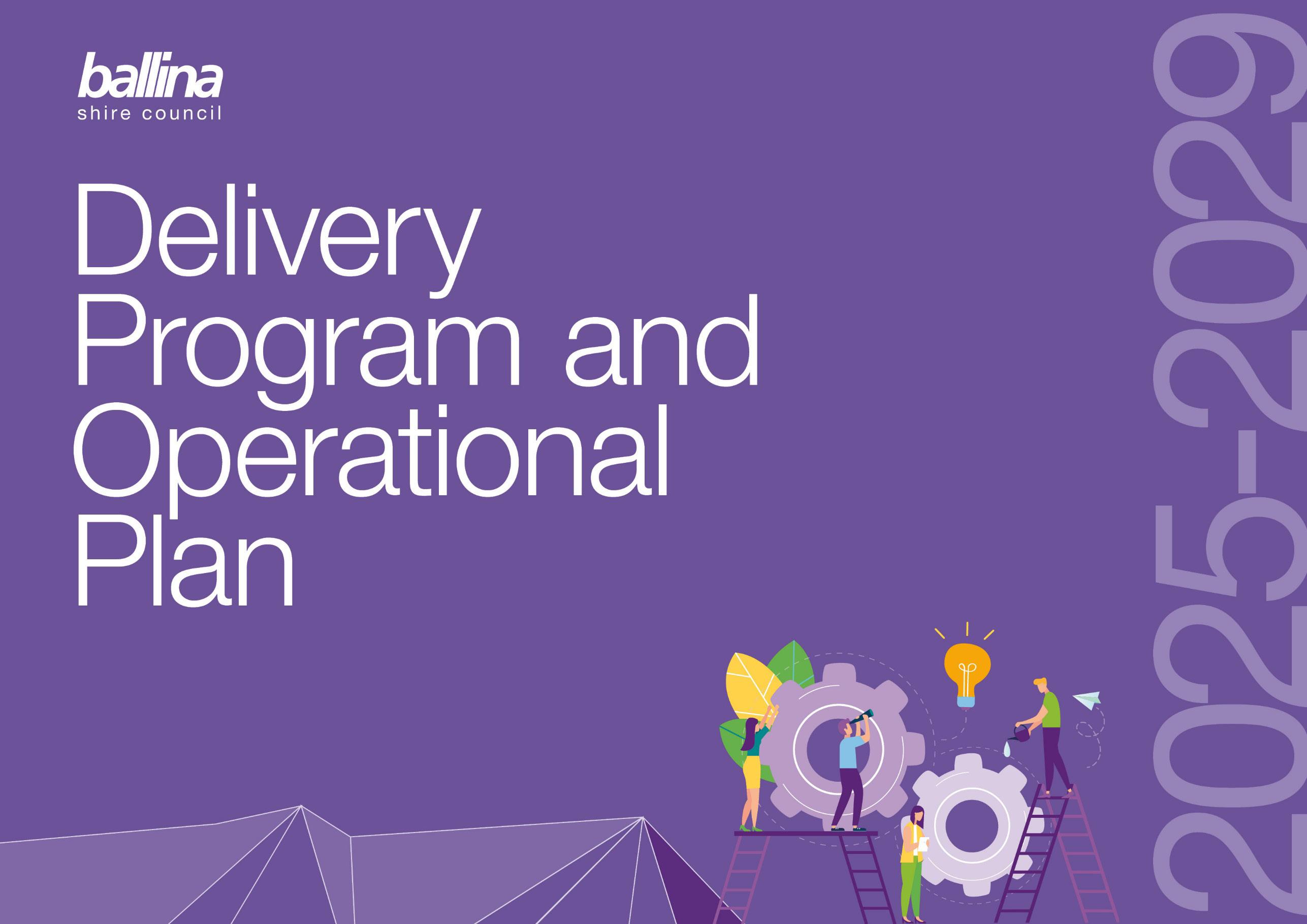
Adopted 26 June 2025
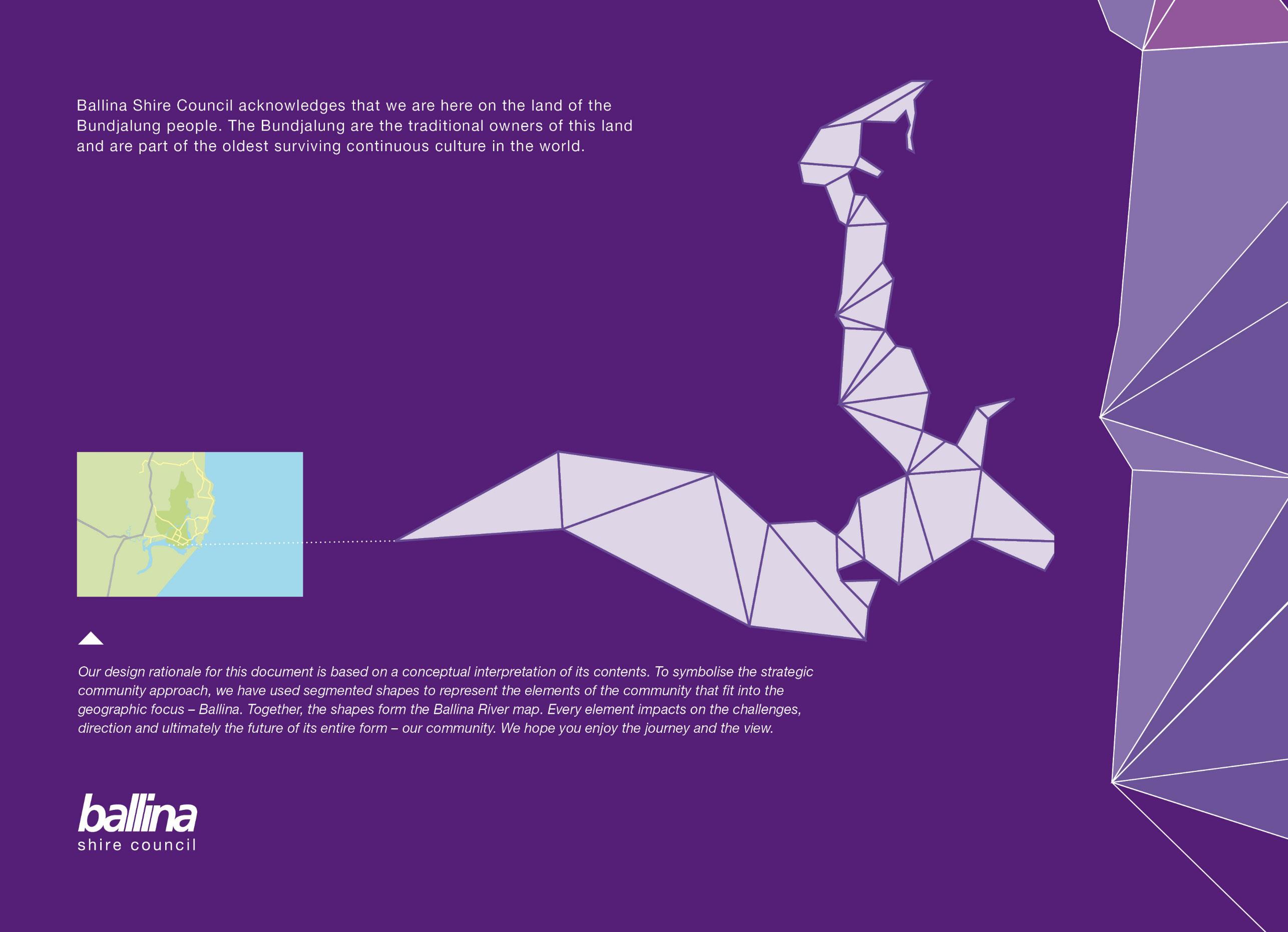


Adopted 26 June 2025

I am pleased to present the Delivery Program and Operational Plan (DPOP) for 2025/26 to 2028/29. This plan outlines Council’s priorities for the next four years and details the services, infrastructure, and initiatives we will progress to support our community’s needs.
It also reflects the long-term aspirations captured in our Community Strategic Plan (CSP), developed through extensive consultation with our community.
Council continues to focus on providing essential services such as roads, waste, water, parks, and community facilities, the things that keep our shire running and support a high quality of life. In 2025/26, we will continue to advance several key projects including:
• Alstonville Cultural Centre Redevelopment – commence construction of a new library and upgraded multipurpose space to create a modern, inclusive community facility.
• Fishery Creek and Canal Bridge Duplications – commence duplication works for these two critical bridge crossings and strengthen Ballina’s transport network.
• Ballina SES Building – construct the new SES building for Ballina, on the corner of Angels Beach Drive and Bangalow Road.
• Ballina Pump Track – complete construction of a new pump track on Kingsford Smith Reserve, Ballina
• Lennox Head to Cooper Close Shared Path – add another major extension to our existing shared path network, by constructing an extension from Byron Street, Lennox Head to Cooper Close, adjoining Ross Lane.
These projects are made possible through strong partnerships with the NSW and Australian Governments and the ongoing support of our community.
The DPOP is reviewed annually to ensure we remain responsive to emerging challenges and opportunities while aligning with the broader goals of the CSP.
It forms part of the NSW Government’s Integrated Planning and Reporting Framework and guides our work alongside key documents like the Resourcing Strategy.
This DPOP also includes a proposal to apply for a special rate variation to the Independent Pricing and Regulatory Tribunal (IPART), with this decision to be made by Council towards the end of 2025. The additional revenue, if approved, will increase our spending on key infrastructure areas such as roads, open spaces and community facilities. Refer to Part 4 for further details.
Your input plays a vital role in shaping our priorities. You can stay informed and have your say by registering at Your Say Ballina, Council’s online engagement hub. It’s a great way to be part of the conversation and help shape the future of Ballina Shire.

Cr Sharon Cadwallader Mayor
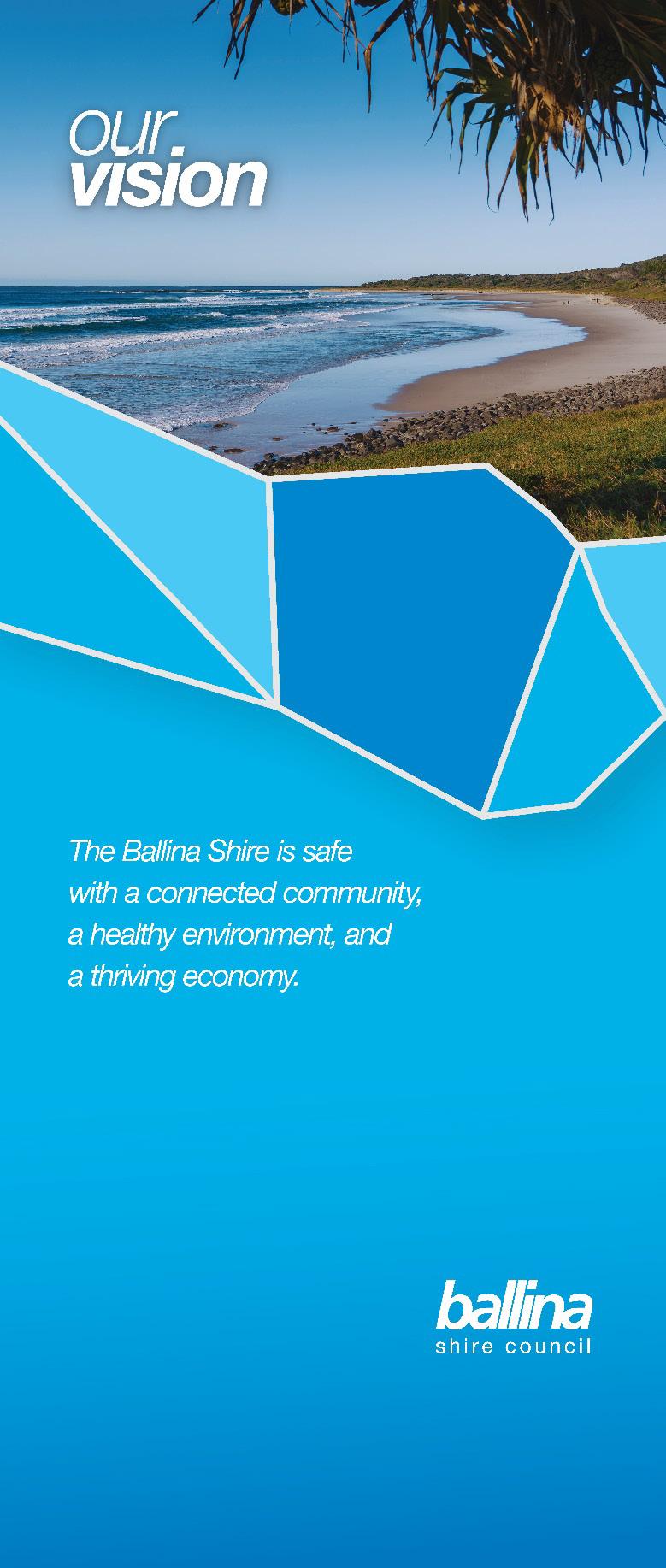
The Ballina Shire is safe with a connected community, a healthy environment, and a thriving economy.
CREATIVE encourage ideas and fostering innovation.
ACCESSIBLE being responsive and approachable to our community and fellow employees.
RESPECTFUL taking responsibility for actions and valuing diverse options.
ENERGETIC embracing enthusiasm in our approach to work.
SAFE prioritising safety in all actions and ensuring everyone arrives and leaves work safely.
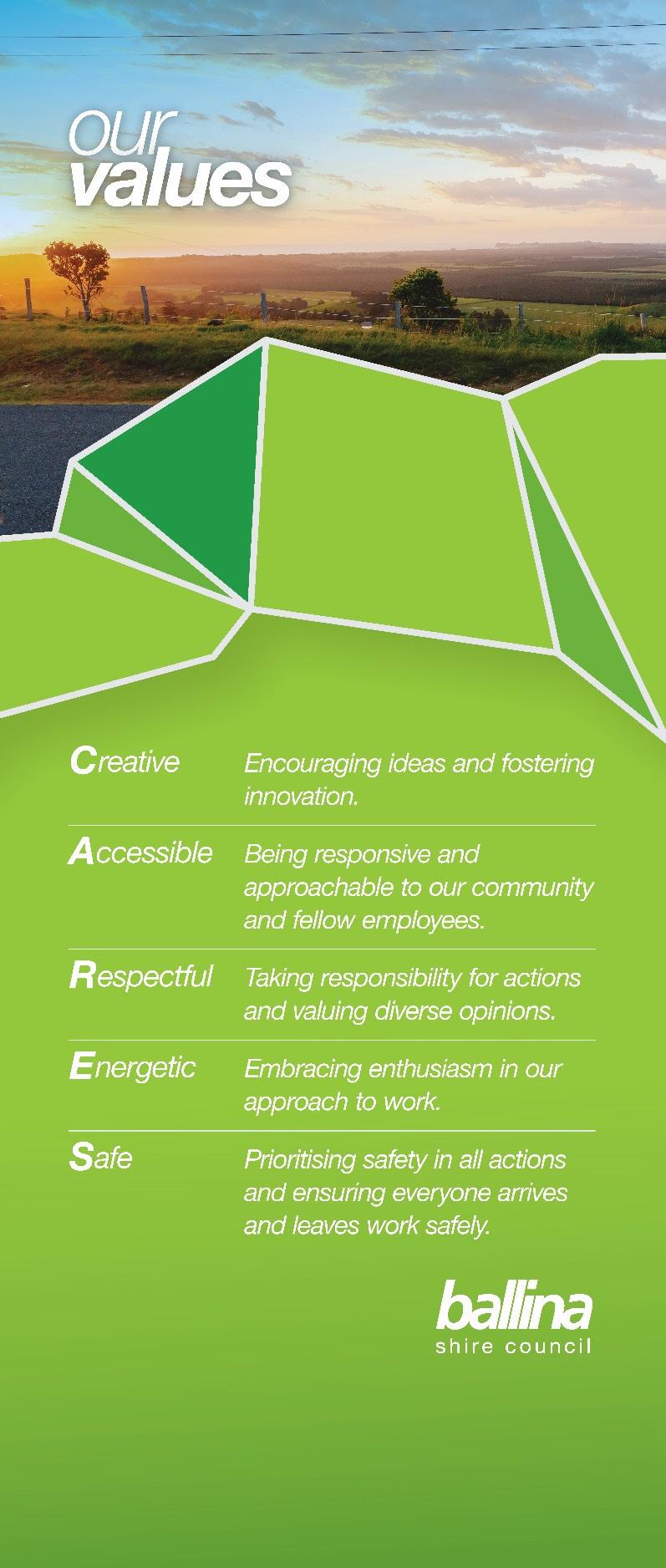
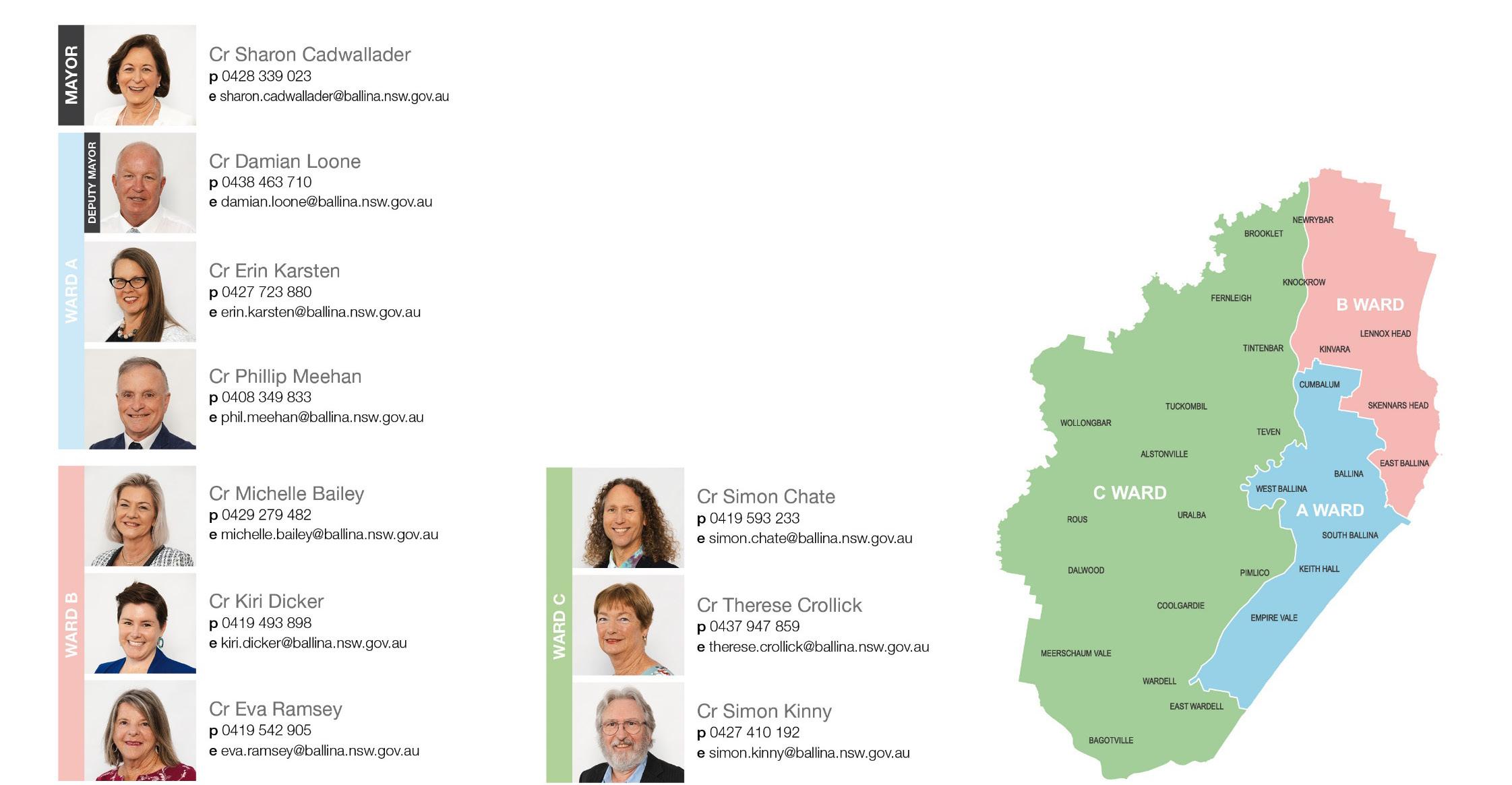
Councillors are elected in Wards; however, each Councillor represents the entire community and can be contacted on any matter. You can contact Councillors in person, by phone or email.



The elected Council is responsible for the direction and control of Council’s affairs in accordance with the NSW Local Government Act and associated legislation.
Councillors represent the interests of our residents and ratepayers.
They serve the community by listening to people and then representing those views on Council.
They work together to make decisions about what the Council will do to meet community needs and how money should be spent in the best interests of the community.
They provide leadership and guidance to the community and facilitate communication between the community while maintaining the broader vision, needs and aspirations of the whole Ballina Shire community.
Councillors do not get involved in the day-to- day running of the Council.
This is the role of the General Manager.
There are several ways you can get involved and help shape decisions for our community by:
• Attending Council meetings
• Making an appointment to speak with the Mayor or Councillors
• Making an appointment to speak with the General Manager or relevant Director
• Writing or calling Council about issues important to you
• Attending a public meeting or forum on specific issues
• Joining a Council Ward Committee as a representative of a community group
• Visiting Your Say Ballina, registering for updates, and participating in Council’s community consultations.
All councils in New South Wales operate under the Integrated Planning and Reporting (IP&R) Framework, established by the NSW Office of Local Government to ensure a strategic and coordinated approach to planning.
It serves as the foundation for all of Council’s plans, ensuring that everything we do responds to community priorities while also addressing essential business-as-usual service delivery. It integrates planning, delivery, resourcing, and reporting.
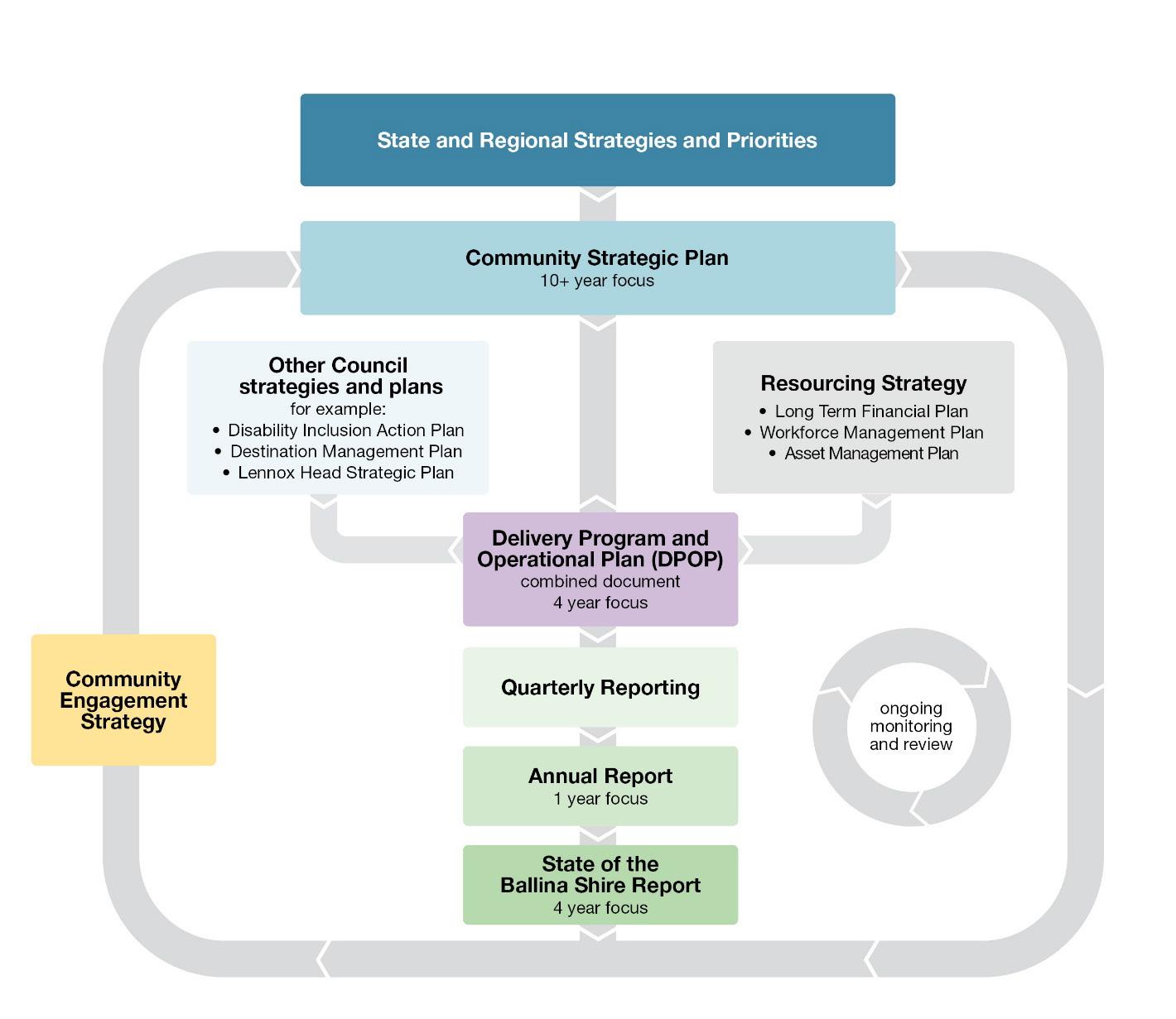
“Ballina Shire is connected, sustainable, and a thriving community where growth is balanced with protecting our environment, enhancing liveability, and supporting a strong local economy.”
This Community Vision, along with our shared priorities and aspirations for the future, is outlined in the Community Strategic Plan (CSP).
The CSP is built around four key directions and sets the direction for the next 10 years, reflecting the priorities of our community. These directions are translated into strategies and actions in the four-year Delivery Program and the annual Operational Plan.




The NSW Government’s Integrated Planning and Reporting (IPR) framework (illustrated on page 6) guides how local governments identify and respond to community priorities and aspirations.
It ensures long-term goals are translated into actionable plans through a structured approach.
This framework connects strategic objectives with practical implementation through a series of linked documents, including:
1. Community Strategic Plan
2. Delivery Program and Operational Plan
3. Resourcing Strategy
Council reports to its community how it has progressed in achieving these plans through:
1. Quarterly Reports
2. Annual Report
3. State of Ballina Shire Report.
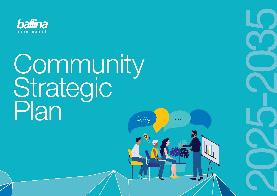
At the core of the IP&R Framework is the Community Strategic Plan, a ten-year plan that establishes the community’s priorities. It is built around four key questions:
1. Where are we now?
2. Where do we want to be in 10 years’ time?
3. How will we get there?
4. How will we know when we have arrived?
While Council takes the lead in developing this Community Strategic Plan (CSP), the plan does not belong to Council; it belongs to the community. It reflects the priorities identified through extensive community engagement. Council, alongside government agencies, businesses, and community organisations, plays a key role in delivering these community priorities.
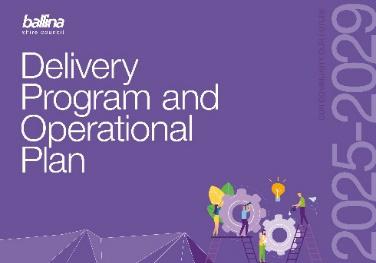
The Delivery Program and Operational Plan 2025-2028 outlines Council’s role in delivering projects and services during the four-year term of the elected Council. These plans detail the planned projects, services, and budgets for each year, ensuring alignment with long-term strategic goals.
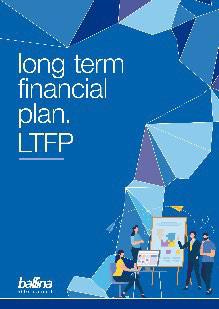
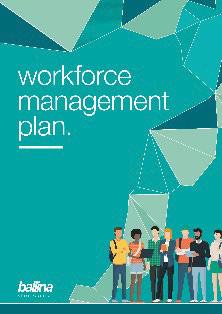
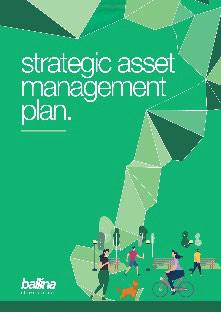
The Resourcing Strategy outlines Council’s capacity to manage assets and deliver services. It includes:
• A Long-Term Financial Plan, for the next 10-years, to ensure financial sustainability,
• A Workforce Management Plan to support a capable and efficient workforce, and
• Asset Management Plans to maintain and enhance community infrastructure.
Council’s progress in delivering projects and services is monitored through budget reviews and key performance indicators. Quarterly Updates are reported to Council after each quarter (March, June, September), except December, which is reported in February.
The Annual Report provides a review of Council’s performance over the previous financial year, measuring progress against the Delivery Program and Operational Plan. It is reported to the November Council meeting.
A State of the Ballina Shire Report will be published after the 2028 Council election. It assesses how the shire is progressing against the community priorities in the Community Strategic Plan, including updates on key Community Indicators.
Our community aspirations have been grouped under four themes, referred to as Directions. The Directions apply the Quadruple Bottom Line (social, economic, environment and civic leadership) to provide a holistic approach to achieving our vision. The Directions and Outcomes identified in our Community Strategic Plan are as follows, with every Delivery Program and Operational Plan Strategy and Action then linked to these Directions and Outcomes.

The health and preservation of our natural environment was a strong recurring theme from our community engagement. We want to continue to find a balance between development and the environment to ensure we preserve what people love so much about living in the Ballina Shire.
We want to restore and repair our waterways and areas that have been degraded to maintain aquatic and native wildlife. We understand the importance of preserving, enhancing and having access to nature areas. We want our built environment to meet our needs but not at the expense of our natural environment or the people who live and work here:
HE1 We project, respect, and enhance our natural environment
HE2 Our operational choices are based on sustainability and limit our impact on the environment
HE3 Our built environment is respectful of the natural environment and the ecosystem

During our community engagement people told us they want to have confidence and trust in their leaders, and they want Council to take a more active role in advocating for its needs. They also want a genuine partnership with Council where their voices are heard and their opinions respected.
Our community wants resources to be used efficiently and responsibly. People want Council to act locally but to also work effectively and collaboratively with other levels of government, private sector organisations and community groups to drive economic and social prosperity.:
EL1 Decision making is inclusive, transparent, and underpinned by sustainability
EL2 Council’s finances and assets are well managed
EL3 Our leaders work effectively with other levels of government and councils

People told us they want to feel connected to a community which is friendly inclusive and tolerant of all ages and cultures.
We want to feel safe and supported. We want to live in an area that has a relaxed and active lifestyle, where we know our neighbours, and where people are welcoming. From the young to the old, no matter the wealth or background, the needs of all residents are treated with respect and dignity:
CC1 We feel safe and resilient
CC2 We have a sense of belonging within the community
CC3 There are services and facilities that suit our needs

Our Community wants a vibrant and diverse local area that provides and has access to a range of activities, jobs and opportunities for all ages. Importantly, we want vibrant town centres that contain a diverse range of retail and night-time activities that are interesting and provide ongoing job opportunities. These central areas can also be supported by attractive foreshores. We want these to be sustainably enjoyed, from recreational use to low-scale improvements that celebrate these key assets.
We want facilities to be accessible via safe transport networks; and attractive to innovative and progressive businesses and people that will ensure our villages and towns continue to thrive and prosper.:
LP1 Liveability is high across the shire
LP2 We are an attractive destination
LP3 We support business diversity, sustainability, and choice
Local Government is legislated by the NSW State Government, and it is important that our plans align with both State Government’s priorities and regional plans.
Our strategies and activities are linked to the following goals in the NSW Government’s North Coast Regional Plan 2041 (NCRP).
GOAL 1: Liveable, Sustainable and Resilient
GOAL 2: Productive and Connected
GOAL 3: Growth, Change and Opportunity
Further information on the NCRP download: North Coast Regional Plan 2041
The Independent Pricing and Regulatory Tribunal (IPART) annually set a rate peg limit, which limits the amount by which councils can increase their total rate revenue from year to year. IPART has announced a rate peg of 3.8% for Ballina Shire Council for 2025/26.
The rate peg legislation caps the limit a council’s rate income can increase by each year. Individual rates, on properties, can vary up and down by more than the rate peg percentage, as rates are levied on land values, but importantly the total income to Council is capped by that peg limit.
This limit applies to ordinary rates only, being the rates levied on a property’s land value, and does not apply to water, wastewater, stormwater and waste collection charges.
Council’s long-term financial plan is constantly reviewed to ensure that adequate services are delivered to the community and sufficient funds are available for asset renewal and expansion.
Based on several measures, including our low staff numbers per resident, our comparably low average rate income per property, as well as forecast operating deficits, Council is concerned that we do not have sufficient rate revenue to continue to deliver services in line with community expectations.
As a result of this, Council has resolved to commence a consultation process to consider an additional rate increase above the annual rate peg limit, over a four-year period from 2026/27 to 2029/30.
The proposal is to permanently increase our total general rate income by way of an application to IPART, for a Special Rate Variation (SRV). If approved, this will increase our general rate income above the standard rate peg limit, which will allow Council to increase the level of revenue allocated to capital and operating expenditure. This extra revenue will fund increased capital expenditure on roads and footpaths, stormwater, open spaces and sporting fields, and community facilities.
Additional expenditure is also proposed to improve our waterways, enhance our biodiversity and implement crime prevention programs.
Prior to proceeding with further community consultation and any application to IPART, it is important that Council’s Delivery Program and Operational Plan (this document) outlines the SRV proposal.
In summary, Council is proposing to apply to IPART, for an SRV across four financial years from 2026/27 to 2029/30. Council will be applying for a 6.00% increase in our rate income for each of the four financial years from 2026/27 to 2029/30. The 6.00% represents an estimated 3.25% rate peg, and a 2.75% additional increase, for each year. This represents a cumulative increase of 26.25% by 2029/30, which is 12.6% above the cumulative increase that would result from the 3.25% estimated rate peg for the four-year period. This increase will be built into the rate base and permanently retained, if approved by IPART.
For further information and a summary of the annual and cumulative increases of this proposal, along with the works program refer to the following page and Appendix B.
Table One – Rate Peg Only Comparison
Table One is based on the standard rate peg increase without any special rate variation.
Two key items of information in this table are:
1. The 3.80% rate peg percentage increase for 2025/26 is the actual rate peg determined by IPART for that financial year.
2. The 3.25% applied for 2026/27 to 2029/30 years is an estimated rate peg increase.
Table Two – Proposed SRV (for 2026/27 to 2029/30)
Table Two provides details of an SRV on top of the estimated rate peg over a four-year period.
Two key items of information in this table are:
1. The 3.80% rate peg percentage increase for 2025/26 is the actual rate peg determined by IPART for that financial year.
2. The 6.00% applied for 2026/27 to 2029/30 represents an estimated rate peg of 3.25% and an additional 2.75% (11.0% divided over four years) each year.
Appendix B provides a comparison of expenditure programs with and without the SRV, along with other important information on the SRV.
Councillors adopt an organisation structure that supports the position of General Manager in implementing the Strategies and Actions identified in the Delivery Program and Operational Plan. The adopted organisation structure is as shown.

Council has developed the Delivery Program and Operational Plan to achieve the Directions and Outcomes identified in our Community Strategic Plan.



1. Healthy Environment (HE)
2. Engaged Leadership (EL)

3. Connected Community (CC)
4. Liveable and Prosperous Community (LP)
This section provides details of the major Delivery Program Strategies, including the Operational Plan Actions, scheduled for the next four years.
Our success in achieving the Actions identified for 2025/26 will be reported to Council on a quarterly basis - in the month following the end of each quarter (March, June, September), except for December, which is reported at the February meeting.
To encourage continuous improvement, Council undertakes an independent community satisfaction surveys every two years and participates in the Local Government Performance Excellence Benchmarking Program. This information helps inform the priorities of Council.
As part of our commitment to continuous improvement, Council has established a Business Process Mapping Taskforce which reviews existing processes to identify opportunities to improve our systems.
Management also conduct reviews of service delivery where operational efficiency opportunities are identified.
Our Audit, Risk and Improvement Committee, which consists of three independent representatives, also helps to support our on-going improvement.
Our planning considers past and predicted changes to the
Undertake and promote initiatives that improve
HE3.1
Develop
Facilitate and develop strong relationships and partnerships with the community
More people feel they can have a say on important issues.
We are known for being prompt, knowledgeable, friendly and helpful.
Involve our community in our planning and decision-making processes Improved satisfaction levels with Council’s consultation
The community understands the planning and decision-making process.
Incorporate
Ensure a balance budget, with revenue opportunities combined with cost savings and efficiencies. Council remains financially viable resulting in effective and sustainable asset management
Actively promote safety and wellbeing strategies
Lower crime rates against people and property
Reduce incidences of non-compliance through proactive programs
Community is confident that services meet public health standards (pool fences, dogs, food premises, health premises, drinking water health, swimming water health
CC1.1
Actively promote safety and wellbeing strategies
Lower crime rates against people and property
Reduce incidences of non-compliance through proactive programs
Community is confident that services meet public health standards (pool fences, dogs, food premises, health premises, drinking water health, swimming water health
CC1.3
Monitor the built infrastructure and the services delivered to the community to ensure relevant standards are being met High
members of our community are well supported
Increase in events and community participation
CC2.1c
CC3.3 Support
Support
Facilitate
LP3.3
Provide efficient and cost-effective regulatory environment for doing business Easier to do business
This section outlines the capital expenditure planned for the four-year period from 2025/26 to 2028/29 The expenditure program for 2026/27 to 2028/29 includes additional funding from the proposed SRV.
Kingsford Smith, Ballina - Pump Track
Kingsford Smith Ballina – Improvements
Saunders Oval, Ballina - Cricket Pitch
Winton Lane, Ballina Segment 20
Temple Street, Ballina Segment 10 and 20
Preliminary Designs (2026-27 program)
Mary Street, Ballina Segment 10
Kalinga Street, Ballina Segment 30
Street, Ballina Segment 20
Drive, Alstonville Segment 30
Skennars Head Road Segment 80
Skennars Head Road Segment 70
Cawarra Street, Ballina Segment 20
Owen Street, Ballina Segments 20 and 100
Cherry Street, Ballina Segment 180
Cherry Street, Ballina Segment 30
Creek Road Segment 80
Street, Alstonville Segment 30
Barlow's Road, Ballina Segment 20
Street, Lennox Head Segment 40-50
Street, Alstonville Segment 5
Avenue, Ballina Segment 10
Ballina Segment 30
Ballina Segment 10
Gardens, Ballina Place Segment 10
Street, Ballina Segment 10
Street, Wardell Segment 10
Grant Street, Ballina Segment 40
Bagot Street, Ballina Segment 30
Tweed Street, Ballina Segment 30
Drive, Alstonville Segment 20
Street, Ballina Segment 10
Lennox Head Segment 10-20
Creek Road Segment 190-200
Cherry / Moon / Grant Streets, Ballina - Pavers / Kerb
Rural Roads
Pimlico Road Segment 100
The Coast Road Segment 200 362,000 Marom Creek Road Segment 60
Houghlahans Creek Road part Segment 150
Bagotville Road Segment 30
Dalwood Road Segment 80
Fernleigh Road part Segment 90
Roads (continued)
Dust Seal Program
c) Bypass Reserves
e) Section 7.11 Roads Plan
f) Loan, Grant Funds and Miscellaneous
Betterment - Ross Lane Flood Resilience
EPAR 2022 Floods Landslip Teven Road
EPAR 2022 Floods Landslip Towalbyn Place
EPAR 2022 Floods Landslip Hinterland Way, Tintenbar
EPAR 2022 Floods Landslip Uralba Cutting Road
EPAR 2022 Floods Landslip Forest Road, Uralba
EPAR 2022 Floods Landslip The Coast Road, Lennox Head
EPAR 2022 Floods Landslip Sneaths Road
EPAR 2022 Floods Landslip Marom Creek Road
EPAR 2022 Floods Landslip Tamarind Drive
EPAR 2022 Floods Bagot Street
EPAR 2022 Floods North Creek Road
EPAR 2022 Floods Owen Street
EPAR 2022 Floods Tamar Street
Council Landslip Old Byron Bay Road
Cumbalum Road Rock Wall Revetment Works
Reedy Creek Road Segment 10 Foam Bitumen Stabilisation 300,000
Safety Improvements -Rifle Range Road - Grant Funded
River Street - Recovery and Resilience Funding 2,165,000 6,200,000
Ballina CBD Revitalisation – River / Martin Street – Part Grant
Wardell CBD Revitalisation – To the Rive Stage – Part Grant
Denison - Car Park
The Coast Road - Pat Morton - Line Marking
Rock Road - Line Marking
Street near Club Lennox - Line Marking
Preschool - Lighting
Preschool - Lighting
Rescue Tower - Lighting
Ballina Skate Park - Lighting
Lake Ainsworth - Ross St - Lighting
Shelly Beach Road (south of SLSC) - Lighting
Shelly Beach Road (north of SLSC) - Lighting
Pop Denison Park - Lighting
Pacific Parade at Ross Street - Lighting
Rutherford Street - Line Marking
Alston Avenue (Pool) - Line Marking
Alstonville Cultural Centre - Line Marking
Pop Denison Park - Line Marking
Beach Road (Suvla St) Car Park - Line Marking
Shelly Beach Road (Suvla St) - Line Marking
Shelly Beach Road Car Park - Line Marking
Wardell Sports Ground - Lighting
Fox Street (Meldrum Park/Martin St), Ballina
Lennox Head
Lennox Head
CURA B Distribution Main
Bentinck Street (Owen / Kingsford Smith), Ballina
Temple Street (Tamar / Tamarind), Ballina
Angels Beach Drive to Missingham, Ballina
Basalt Court Gravity Main Augmentation, Lennox Head
Wardell
Wardell -
Wardell -
Wardell -
Wardell
Lennox
Lennox
Lennox
Lennox
Lennox -
Lennox -
Lennox -
Lennox –
Lennox
Lennox -
Lennox -
Lennox -
Lennox -
Facilities - Minor Works
Trunk Mains
Main - Swift Street, Ballina
-
Main - SP2402 Lindsay Avenue
Main - SP3001 Byron Street
Stations
Stations - Switchboard
Pumping Station - SPS 2101 Rebuild
Pumping Station - Odour Control
Pumping Station - SP2402 Pump Upgrade
Reuse Program
Main - Lennox Head
Main - Fig Tree Hill
Distribution Main - CURA B
Extension - Palm Lake
Reuse Program (continued)
Connection – Convair and Airport
Main - Ferngrove to Ballina
Links Ave to Prospect Bridge
Links Ave to Chickiba RW Main
RWP61 Lennox Head
RWP63 Lennox Head
Recycled - Canal Bridge to Ferngrove
Recycled - Canal Rd (Saunders)
Plant and Equipment and Miscellaneous
Whereas the Delivery Program has a focus on a four-year period, the Operational Plan outlines the activities to be undertaken for one year, which in the case of this document is 202 5 /2 6
In respect to the key activities and the measures that we will be using to assess our performance, the 2025/26 column in the “Heading in the Right Direction” of the Delivery Program lists all the agreed activities and measures.
Similarly, the Capital Expenditure section of the Delivery Program also includes the major capital expenditure projects planned for 2025/26.
The balance of the Operational Plan, as follows, includes the mandatory elements specified in the NSW Local Government Act, along with other items of interest.
Briefly the remaining elements of this document are as follows
Estimated
The Income Statement is the primary indicator of how Council is performing financially, on an annual basis, and this section provides the estimated income statement for 2025/26
Even though the Operational Plan focuses on one year, it is important to understand how Council’s finances are trending. This section provides a summary of Council’s ten-year financial plan.
Council delivers a wide range of services and to understand the net cost, or surplus, generated for each service, this section provides an operating result for the major Council program areas
Many Council delivered programs operate at a net cost to the community and this page provides a useful overview of how the ordinary rates raised from an average residential property are distributed across the loss-making programs.
This statement provides a summary of the various rates and charges that Council will levy during 2025/26.
It provides details of the rating structure along with information on the major charges such as water, waste, and wastewater.
Other mandatory items included are the pricing methodology Council has adopted in preparing its fees and charges for 2025/26, along with details of the proposed loan borrowings.
This final section of the Operational Plan provides details on several miscellaneous items such as Council’s Donation Programs and our Commercial Activities.
Appendices
The appendices to the Operational Plan provide a map outlining the Road Reconstruction Program and further information on the proposed Special Rate Variation.
Council’s Annual Financial Statements are prepared in accordance with Australian Accounting Standards and the NSW Local Government Act.
The key financial statement that measures the performance of Council on an annual basis is the Income Statement. To ensure long term financial sustainability Council needs to be aiming for a net operating surplus within the Income Statement, once Capital Grants and Contributions provided for Capital Purposes are eliminated.
Revenues from Water and Wastewater Operations must be expended on those activities. This means it is necessary to record those areas of Council’s operations as separate funds and the remaining operations of Council are referred to as the General Fund.
The following figures provide the forecast Income Statements for the three funds operated by Council in accordance with Note D1 of the Annual Financial Statements, as well as on a consolidated basis.
Net Operating Result before Capital Grants and Contributions Provided for Capital Purposes
Council is forecasting operating surpluses for the Water and Wastewater Funds and an operating deficit for the General Fund. Council is also forecasting an operating surplus on a consolidated basis. Council’s tenyear Long Term Financial Plan is outlined on the following page.
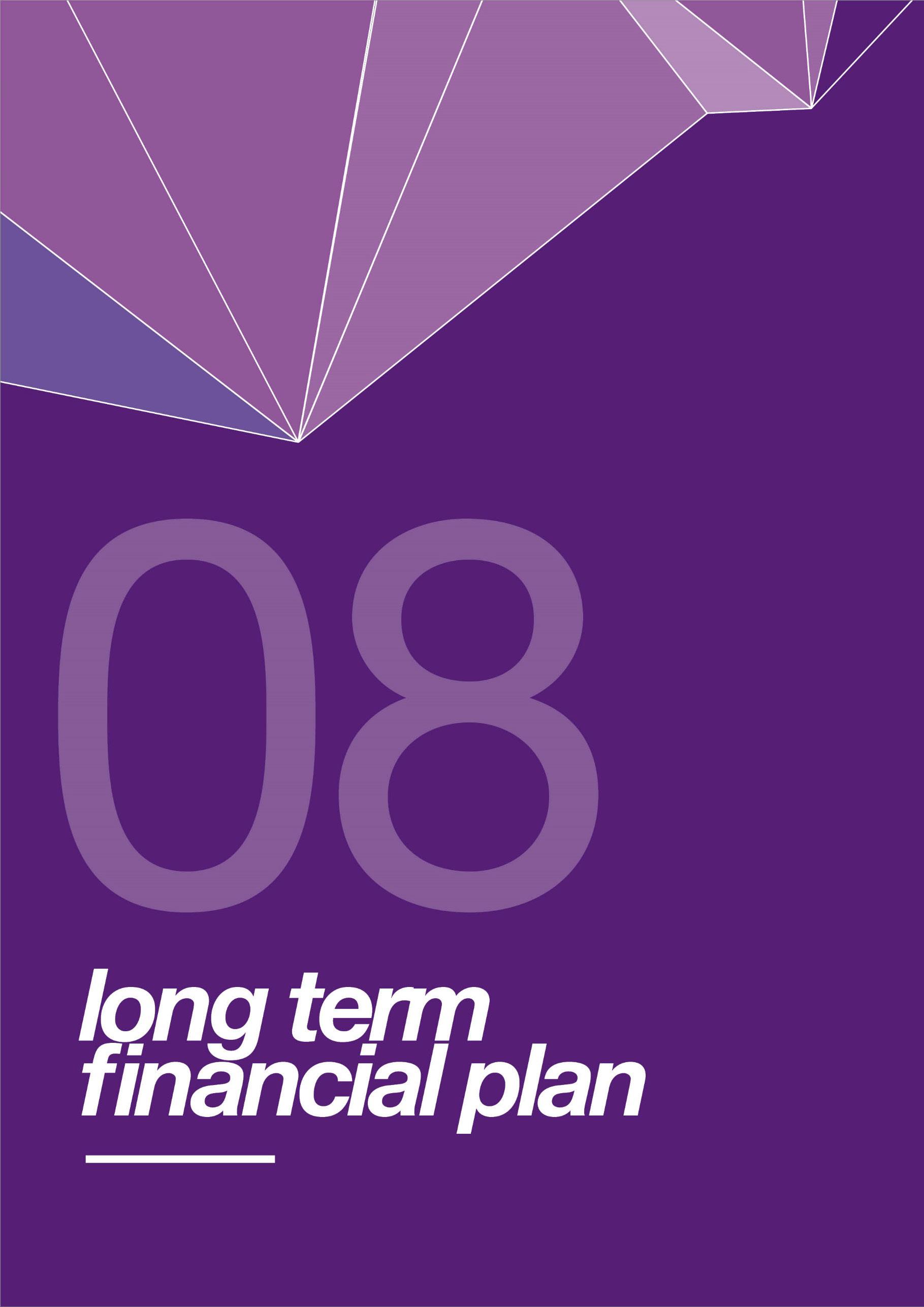
Council’s long term financial plan (LTFP), which is based on a ten-year time frame, has a preferred target of achieving an operating surplus on a consolidated basis and for the General Fund on a regular basis This means that Council needs to look at expense savings or extra revenue, or both, to ensure sustainability for the General Fund.
The LTFP presented (Scenario One) achieves an operating surplus for the General Fund in 2029/30.
This scenario assumes that Council will obtain IPART approval for a permanent increase to our rate income of 6.0% per annum for 2026/27 to 2029/30. This is referred to as a special rate variation (SRV). Further information on our proposed SRV is outlined in Part 4, Part 11 and Appendix B of this document. A summary of our LTFP, as per Scenario One, is as per the following table.
Our Ten-Year Plan to Financial Sustainability – Consolidated Result
(Scenario One – 3.25% rate peg plus proposed 2.75% SRV from 2026/27 to 2029/30)
The following table is the LTFP for the General Fund with the proposed SRV included.
Our Ten-Year Plan to Financial Sustainability – General Fund Result (Scenario One - 3.25% rate peg plus proposed 2.75% SRV from 2026/27 to 2029/30)
Revenues
This table demonstrates that Council’s General Fund is forecast to generate operating surpluses from 2029/30, which is year four of the SRV, assuming IPART approves Council’s application.
Council is pursuing the proposed SRV, as without this extra increase in income, the General Fund will not generate operating surpluses, on a sustainable basis, and it is highly unlikely that any surplus will be generated during the life of this LTFP
The impact of Council not obtaining approval for the SRV is outlined in the following two tables, which are referred to as Scenario Two.
(Scenario Two – estimated 3.25% rate peg from 2026/27 onwards with no SRV)
Expenses
Council does generate an operating surplus on a consolidated basis for the ten-year timeframe however the reason for this is due to operating surpluses for our Water and Wastewater Operations.
As demonstrated in the earlier draft Income Statement for 2025/26, the Wastewater Fund is forecast to generate an operating surplus of $4.9m, which offsets the forecast losses for the General Fund.
The major impact of not obtaining approval for the proposed SRV is outlined in the following table for the General Fund.
(Scenario Two - estimated 3.25% rate peg from 2026/27 onwards with no SRV)
Expenses
This table indicates that the Council’s General Fund does not achieve an operating surplus for most of the ten-year financial plan, without the proposed SRV. It is highly unlikely that the forecast operating surpluses in 2033/34 and 2034/35 will eventuate, as experience has shown that long term forecasts will vary, negatively, often due to unforeseen increases in operating expenses.
Overall, this means that the General Fund is not operating on a financially sustainable basis and Council will not be generating adequate funds to finance the renewal of our existing assets.
It is essential that Council obtain IPART approval for the proposed SRV, as per Scenario One, to ensure that Council’s General Fund is financially sustainable
Otherwise, in the medium to long term, Council will not be investing adequate funds into asset renewal, which will lead to the eventual deterioration of our infrastructure assets and increased maintenance costs.
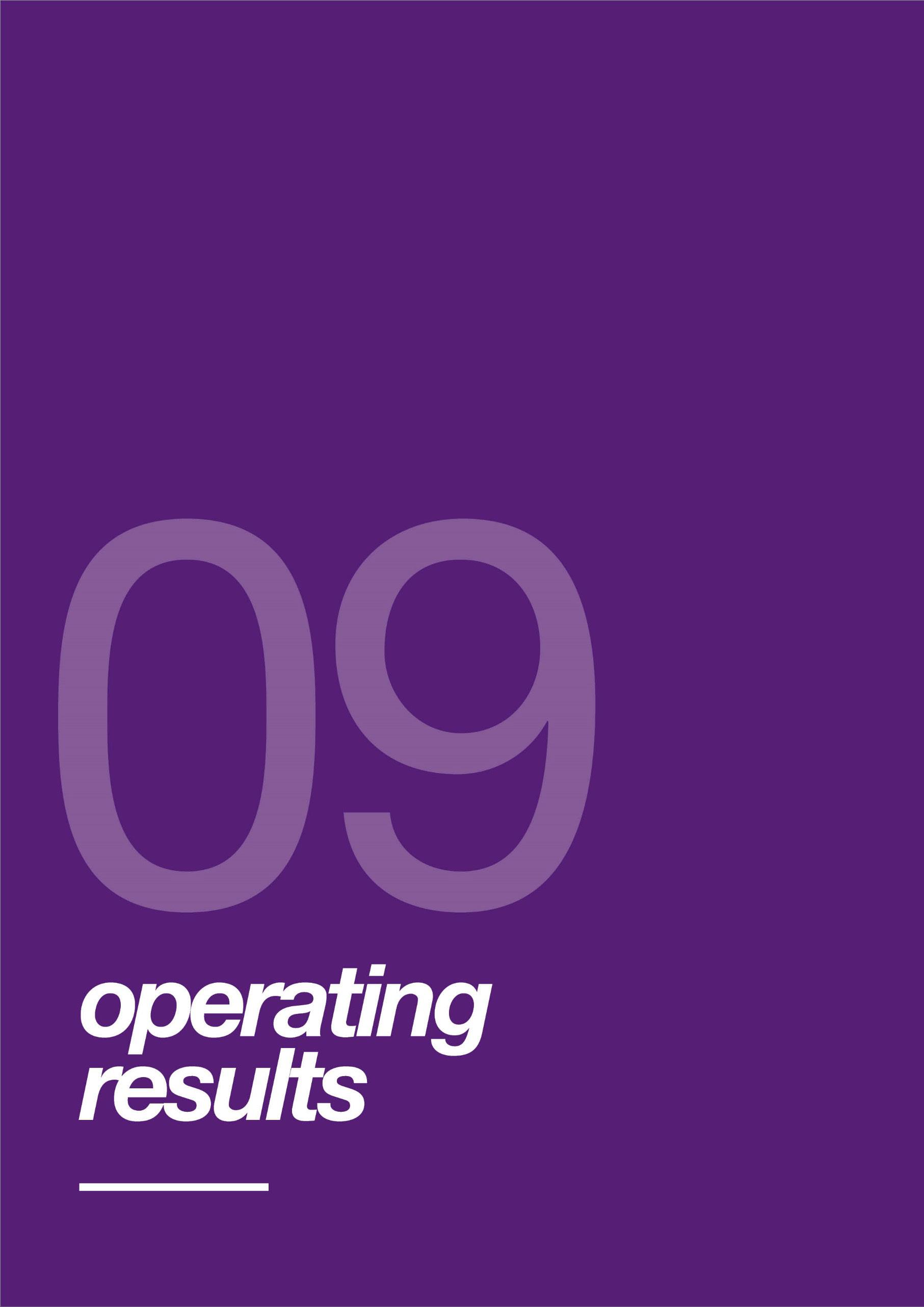
In addition to our Income Statement, which is formatted in accordance with Australian Accounting Standards, it is important for Council to understand the annual operating results for programs and services delivered to the community. The following information is the forecast operating result for 2025/26 based on the major Council programs.
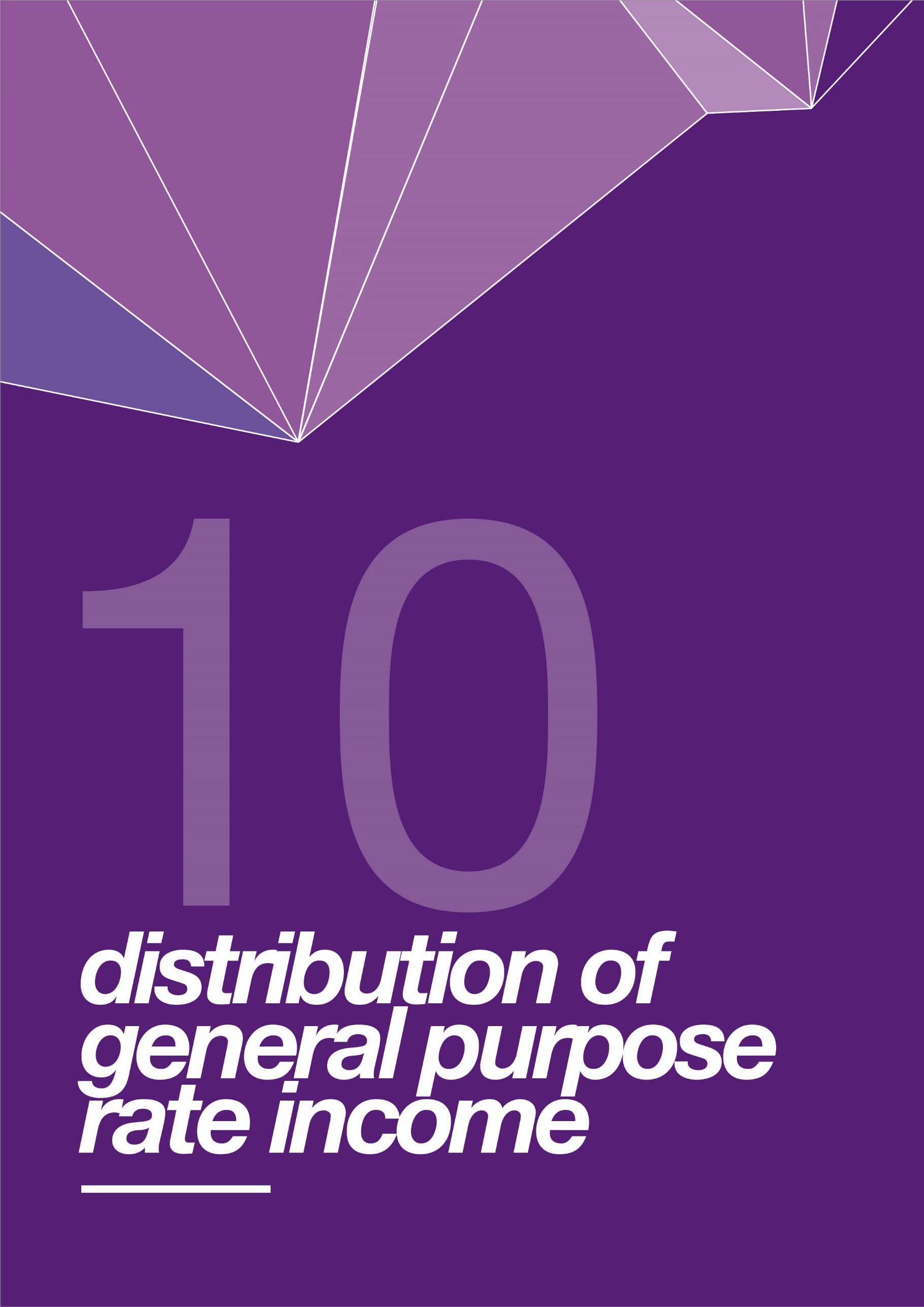
Council provides several services from within the General Fund, the majority of which are subsidised by the income collected from general purpose rates. The remaining programs are self-funded and include fleet and plant, airport, waste management and Council’s property portfolio. This chart illustrates how the average residential rate for 2025/26 of $1,319 is allocated across the subsidised programs.
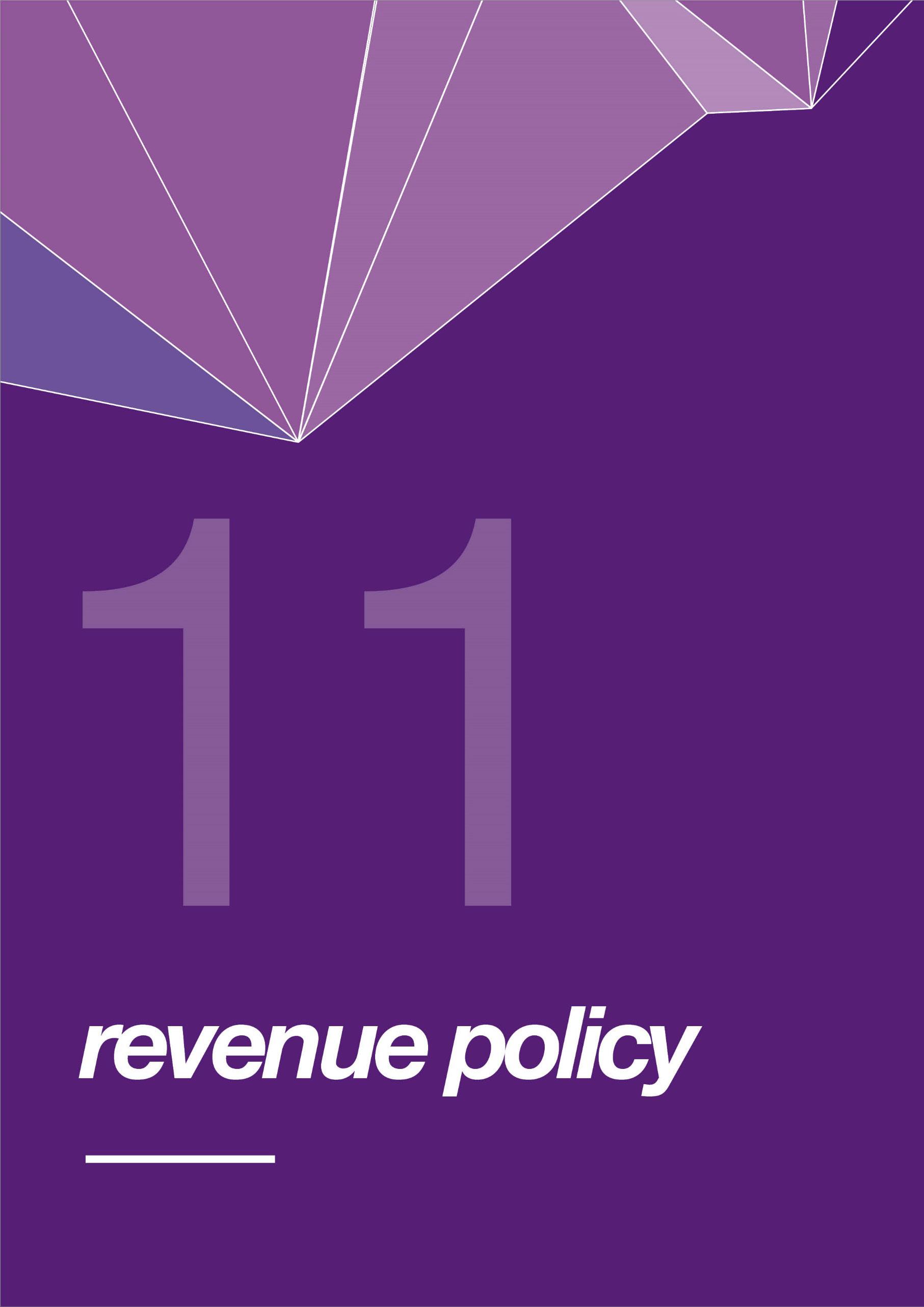
Council’s rating structure incorporates a base amount and a rate in the dollar.
Council is of the opinion that a base amount is the most equitable rating system, as it reduces the impact of land values in calculating rates, and results in a more even spread of the rate burden.
The base amount is a flat charge that is raised equally against all properties in each rating category.
All properties in the shire are categorised based upon the dominant use of the land. The categories allowed under the NSW Local Government Act are residential, business, farmland, or mining. Council has no properties categorised as mining.
The base amount in the residential category is set to raise 50% to the total rate yield for that category. The remainder of the yield for that category is based on the land value multiplied by a rate in the dollar.
The base charge for business and farmland categories is set at the same dollar value as the residential base charge.
This means that in these two categories the base charge raises less than 50% of the yield, as the average land value is higher in business and farmland as compared to the residential category.
It is accepted that land value plays the more dominant role in the rate calculation in business and farmland categories as these properties tend to be income producing.
Increases in a council’s rate income are determined on a percentage basis by the Independent Pricing and Regulatory Tribunal (IPART). This is referred to as the rate peg limit.
For 2025/26 IPART approved a rate peg of 3.8% for Ballina Shire Council.
The following table provides the estimated total rate income for 2025/26
In respect to the proportional contribution to the total yield between business / farmland / residential properties, Council policy has been to generate approximately 20% of the total yield from nonresidential (business) properties.
However, for 2025/26 the percentage is 18.65% as in recent years Council has been aiming to reduce the cents in the dollar differential between business and residential properties, as the current differential, which is almost six times (0.56439/0.09667=5.8) is too high, when considering the impact on land values.
The differential for farmland compared to residential is based on historical figures following the deduction of the business property yield. Council does not have differential rates within rating categories.
Council has resolved to commence a consultation process to seek an additional 11% rate increase on top of the estimated rate peg increase, over a four-year period from 2026/27 to 2029/30.
Council’s long term financial plan is based on an assumed standard IPART rate peg limit of 3.25% for 2026/27 onwards, which means the application to IPART for a permanent increase to our income will need to be as follows, to comply with that plan:
• 2026/27 to 2029/30 – 3.25% estimated rate peg limit, plus a 2.75% additional increase above the estimated rate peg. This represents a total increase of 6% per annum.
A summary of the annual and cumulative increases of this proposal are as follows:
The purpose of the proposed SRV is to increase our general rate income above the standard rate peg limit, which will then allow us to increase the level of funding we provide for both capital and operating expenditure.
The allocation of extra revenue to capital expenditure improves the operating result. This allows for additional expenditure for key infrastructure renewal areas such as roads and footpaths, stormwater, open spaces and sporting fields, and community facilities.
The allocation of revenue to operating expenses does not improve the operating result, as that additional revenue is matched against additional operating expenses. The areas proposed for additional expenditure include maintenance of roads and community facilities and open spaces operations. It is also proposed for additional expenditure on waterways, biodiversity and crime prevention.
Refer to Appendix B for a preliminary works program for the additional revenues generated along with a summary of the objectives behind this program of funding.
The NSW Local Government Act allows council to raise charges for the provision of waste, water, wastewater, and storm water services.
The charges levied by Council in relation to these items are as follows:
Council levies a range of annual waste charges to finance the operation of the Ballina landfill along with the collection and disposal of kerbside waste.
The various charges levied to the different categories of properties are described on the following pages.
Council levies an annual domestic waste collection charge of $473 (2024/25: $448) per selfcontained occupancy, on all urban residential properties, where the service is available.
This service includes a fortnightly kerbside recycling collection service, a fortnightly mixed waste service and a weekly organics collection service.
This annual charge is payable whether the service is used.
Urban properties generally include parcels of land within townships, villages or built up rural residential estates where there are lower speed limits.
Non-strata titled residential units/flats are levied the annual domestic waste collection charge of $473 (2024/25: $448), dependent upon the number of units/flats or rural dwellings contained upon the property.
For example, a non-strata titled multiple occupancy property containing four units/flats will be subject to a total charge of $1,892 ($473 multiplied by four services).
A Domestic Waste Exempt Collection Service $50 (2024/25: $48), is equivalent to the Vacant Land Domestic Waste Collection charge.
This fee applies to properties that are occupied and for which a domestic waste management service is available, but where Council has decided not to provide a collection service. This may occur, for example, for safety or physical limitations of the property.
This fee also applies to multi-unit dwellings approved by Council to utilise an alternative arrangement.
As per urban residential properties, Council charges an annual domestic waste collection charge, per self- contained occupancy, on all rural residential properties, where the service is available.
The charge per annum is $340 (2024/25: $391). The service includes a fortnightly mixed waste and fortnightly recycled waste kerbside collection service. This annual charge is payable whether the service is used or not.
This waste charge is mandatory for each residential parcel of vacant rateable land, for which the service is available.
Properties are charged $50 (2024/25: $48) per annum.
Additional services are available for the following extra annual charges:
• Additional Mixed Waste - Urban (Fortnightly) - $140 (2024/25: $133) per annum
• Additional Mixed Waste - Rural (Fortnightly*) – $140 (2024/25: $267) per annum
• Additional Domestic Recycling – Urban and Rural (Fortnightly) – $114 (2024/25: $108) per annum
• Additional Organics Waste Collection - Urban (Weekly) – $199 (2024/25: $189) per annum
*Note: Change in collection from weekly in 2024/25 to fortnightly in 2025/26.
Council offers a weekly mixed waste collection service at an annual charge of $465 (2024/25: $437) for non-domestic (i.e., commercial / business) properties.
Non-domestic properties can also elect to receive a fortnightly recycling collection service at an annual cost of $229 (2024/25: $216) and a weekly organics waste collection service at an annual cost of $299 (2024/25: $282).
Additional services are available at the same cost per service as the first collection.
Summary of Waste Charges and Net Estimated Yield for 2025/26
Council’s policy is to charge for water through a structure that encourages water users to conserve water. Charges are set to provide sufficient funds to operate, maintain and renew a water supply system and to minimise the use of loan funds for new capital works.
As per the NSW Local Government Act, charges are levied upon land that is supplied with water from Council mains, and vacant land situated within 225 metres of a Council water main, whether or not the property is connected to Council’s water supply, provided it is possible to supply water to the property, if requested.
The water charging structure is made up of two tiers, a fixed annual access charge for all properties and a consumption charge based on actual water consumed.
A small amount of revenue is generated from fire services.
Charges will be made as listed, except for parcels of land exempt from the charge under Section 552 of the Local Government Act 1993 (i.e., land unable to be connected to a Council water pipe or land further than 225 metres from a Council water pipe).
a) For single residential dwellings and strata titled properties - One access charge per annum for each separate rateable assessment. The charge increases with meter size (as per following table). The charge levied on strata titled properties shall be as per the charge for a standard 20mm service for each strata unit.
b) For multiple occupancy dwellings (flats) - Each unit / tenement will be charged the 20mm water access charge.
c) Each parcel of separately valued vacant land to be levied the equivalent of one 20mm service access charge (Section 501(3) Local Government Act 1993).
Water access charges are levied based on financial quarters in advance (i.e. 1 July to 30 September, 1 October to 31 December, 1 January to 31 March and 1 April to 30 June).
Water meters are read on a quarterly basis. Non-residential customers have their access charge levied quarterly. Residential charges are levied annually, and the customer can choose to pay by quarterly instalments.
Summary of Water Charges for 2025/26
Summary of Net Estimated Yield for Water Access Charges for 2025/26
Water consumption charges are levied based on financial quarters in arrears (i.e. 1 July to 30 September, 1 October to 31 December, 1 January to 31 March and 1 April to 30 June).
Water consumed per separate water meter will be charged at $2.99 per kilolitre for the first 350 kilolitres of water consumed and $4.49 per kilolitre for water consumed in excess of 350 kilolitres.
The estimated income from consumption is approximately $10.1 million.
Water consumption charges are levied based on the date the water meter is read.
Strata developments, where individual units are not separately metered by a Council owned water meter, will have all water consumption charges levied on the “Owners Corporation” of the Strata Plan. Refer to Council’s Schedule of Fees and Charges for the charging structure.
The number of water access charges levied on the whole strata complex (i.e., each individual lot), determines the level of water consumption charged at the first step rate.
For example, a complex with four strata units will be levied four 20mm access charges and be entitled to consume 1,400 kilolitres at $2.99 per kilolitre prior to paying for water at the higher tariff of $4.49 per kilolitre.
Strata units separately metered by a Council connected meter will receive individual water accounts (for both access and consumption charges).
Flats are a non-strata unit development with common ownership and are considered as a single rateable assessment under the Local Government Act.
As Council charges an access charge based on occupancy / tenement, each flat assessment will receive a 350-kilolitre allowance at the step 1 tariff for each / occupancy tenement on the property. (See explanation above for Strata Units).
Water charges do not apply to those consumers who are connected to and serviced by Rous County Council.
A water consumption allowance of 100 kilolitres per annum (at 25 kilolitres per quarter) is provided to customers that utilise home dialysis treatment (as advised by the local area health service). Water consumption above the allowance is charged at normal rates.
Council’s policy is to levy charges across all sewered areas of the shire, at a level sufficient to provide funds to operate, maintain and renew the wastewater (sewer) system, to re-pay existing loans and to generate additional reserves to minimise the impact of any major capital expenditure.
Wastewater charges for non-residential properties are based on the volume of water consumed and the water meter size.
Wastewater charges for residential properties relate to averaged meter sizes and water consumption producing a standard annual wastewater charge for all residential tenements.
Wastewater charges are levied upon land that is connected to Council’s sewer mains, and vacant land situated within 75 metres of a Council sewer main, whether or not the property is connected, provided it is possible for the land to be serviced if requested.
Each self-contained occupancy (i.e., unit/flat/dwelling) on a rateable property will be levied an annual charge of $1,106 as will each separate strata titled residential unit/flat.
Non-strata titled residential unit/flat properties will be levied an annual charge of $1,106 dependent upon the number of units/flats contained in the property.
Vacant land will be levied an annual charge of $835
Charges for non-residential properties will be based on a combination of water meter size and water consumption.
These factors are placed into a formula that also includes a sewerage discharge factor (SDF).
The SDF is the estimated percentage of total water consumption that is returned to the sewer system.
The formula used to calculate the annual account is based on the best practice guidelines issued by the NSW Office of Water.
The formula is as follows: SDF x (AC+ C x UC)
Where: SDF = Sewerage discharge factor
AC = Annual Non-residential Wastewater access charge based on water meter size
C = Water consumption measured in kilolitres
UC = Sewerage usage charge per kilolitre = $2.82/Kl
Volumetric wastewater consumption charges for non-residential units and flats will be levied on the Owner’s Corporation of a strata complex or the owner of the property.
Some properties in the Shire are connected to the urban dual reticulation scheme (recycled water). This water is suitable to flush toilets, wash clothes, water garden plants, wash cars and pathways.
Council applies a usage charge only for this water and this charge is set at 80% of the first step of the potable water charge, i.e., 80% of $2.99 is $2.39/kl.
In addition to this, for designated users of bulk recycled water for open space purposes (i.e., Golf Club, Racecourse) the charge will be 10% of the potable price.
A summary of the annual wastewater charges and estimated yield is in the following tables.
This fee is raised on properties with an on-site sewage system in place (e.g. septic tank) in accordance with section 608(2) of the Local Government Act. The fee is as follows and the revenue generated funds an inspection program, general advice we provide to owners, and replaces the need for periodic renewal of approval fees.
Summary of OSSM Charge and Net Estimated Yield for 2025/26
This charge is raised on developed urban properties and Council has resolved to charge the maximum allowable stormwater management service charge on both residential and non-residential properties. The charges and estimated yield are as follows:
Summary of Stormwater Charges and Net Estimated Yield for 2025/26
Stormwater charges for business properties are based on the impervious area of the land. The charge is $25 per 350m2 or part thereof. In respect to business strata units the appropriate business charge is apportioned based on unit entitlement subject to each unit paying a minimum of $5.
Concessions are available to eligible pensioners who are solely or jointly liable for the payment of rates and charges and reside at the property. These rebates are as follows:
• 50% of the combined rates and domestic waste management charges up to a $250 maximum concession
• 50% of water access and consumption charges up to a $87.50 maximum concession
• 50% of wastewater (sewer) charges up to a $87.50 maximum concession
Section 608 of the Local Government Act permits fees to be charged for services provided by Council. Council has adopted the following pricing categories in establishing its fees.
Category Methodology
Business / Commercial Prices are established in accordance with the prevailing market
Full Cost Recovery Fee set to recover the full cost to provide the service
Partial Cost Recovery Fee set to provide services to the community at an affordable cost, the balance being met from general revenue
Fixed by Legislation Fee set by legislation
The details of each fee are included in Council’s Schedule of Fees and Charges. A copy of this document is available at Council’s Customer Service Centre or on our website.
The Local Government Act allows Council to carry out private works on a fee for service basis. Council will generate a surplus on these works and the surplus will be added to the following ratesLabour plus 72.5%; Materials plus 15%; Plant hire at rates set by Council.
Borrowings planned for 2025/26 are $1.25m for Front of House Resource Recovery Centre.
The Local Government Act allows councils to take a compulsory and non-compulsory dividend from Water and Wastewater. The compulsory dividend is payable to the General Fund, based on the lesser of the ‘calculated tax equivalent’ or $3 per assessment.
Council calculates tax equivalent payments when preparing the Special Purpose Financial reports, at the end of each year. They relate to taxes, excluding company tax, from which Council business activities are exempt. Typically, this refers to stamp duty and land tax. The Long-Term Financial Plan includes compulsory dividends of $56,000 from Water and $54,000 from Wastewater.
Under certain circumstances Council may take a non-compulsory dividend from Water and Wastewater. To do this, Council is required to comply with State Government ‘best practice’ guidelines. No non-compulsory dividends have been included within the Long-Term Financial Plan.
Council has determined that there are no other matters prescribed by regulation that require a statement to be included in Council’s Revenue Policy.
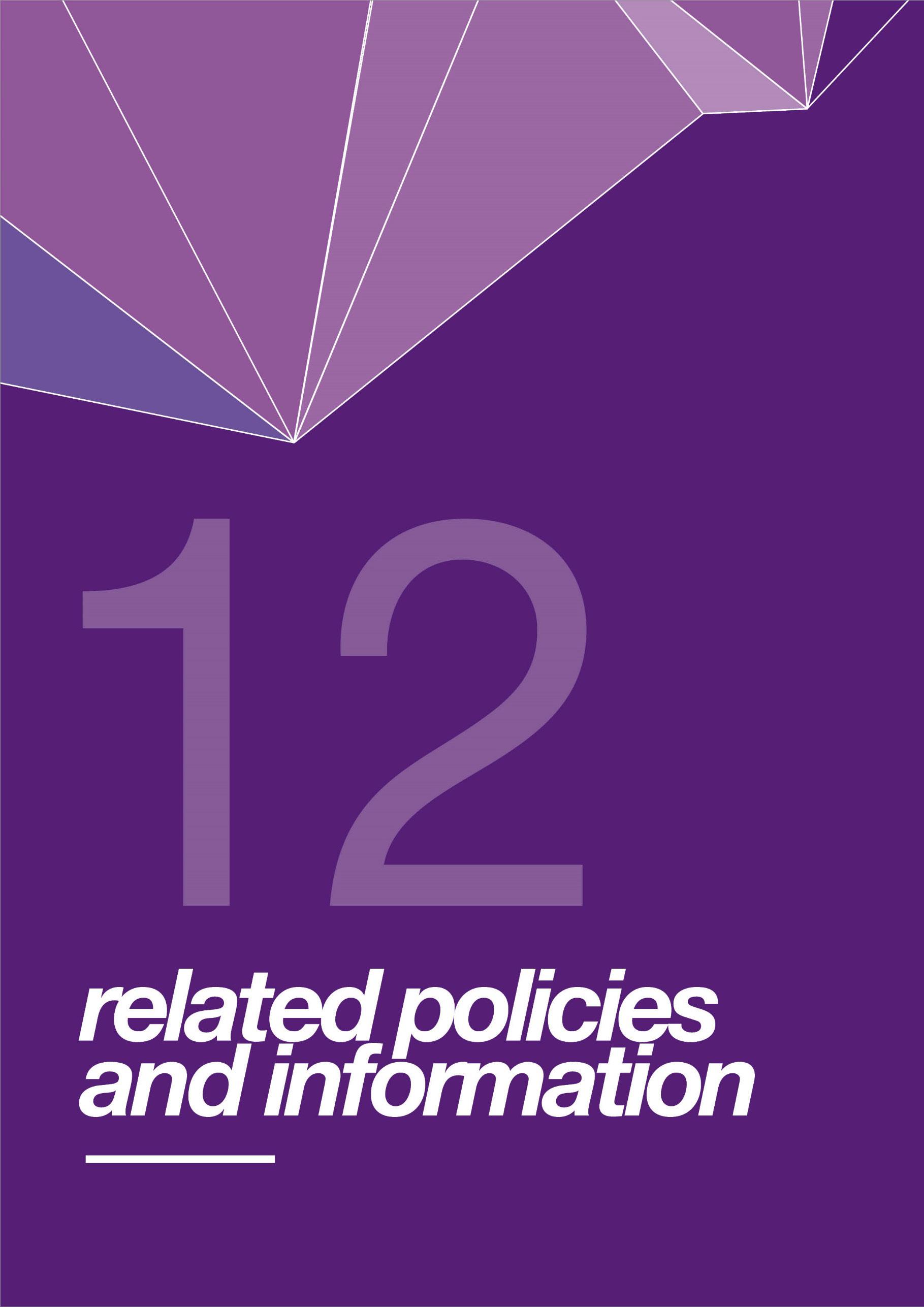
Plant and equipment to be disposed of or replaced has either reached the end of its economic life or is no longer required for Council’s operations.
Council’s passenger vehicles are traded at the time considered the most economically viable, considering age, kilometres travelled, changeover costs and market demands.
Council holds areas of industrial and residential land. If any land is to be sold a resolution will be obtained from Council prior to sale.
The following activities undertaken by Council are of a commercial nature:
Category One Businesses (turnover greater than $2 million)
Category Two Businesses (turnover less than $2 million)
In accordance with National Competition Policy guidelines, Council has included into its costing processes, all direct and indirect costs, plus taxes that a private sector operator would face in the operation of a similar business. These taxes are known as taxation equivalent payments (TEP’s) and are based on items such as land tax and company tax.
For Water and Wastewater operations, Council has adopted a target rate of return of 0%. However, it is acknowledged that operating expenses for Water and Wastewater incorporate the payment of a dividend to General Fund. For other commercial activities, the target rate of return is the Commonwealth ten-year bond rate.
Council has a procedure designed to effectively manage competitive neutrality complaints. This type of complaint refers to instances whereby an actual or potential competitor of a Council business believes that it is being adversely affected through Council’s failure to adopt competitive neutrality.
For enquiries relating to Commercial Activities and Competitive Neutrality contact the Manager Commercial Services, or our Manager Financial Services.
The elected Council approves the allocation of staff resources to support the implementation of the Delivery Program and Operational Plan. The estimated total employee benefits and oncosts for 2025/26 is approximately $37m. Refer to the Workforce Management Plan for estimated staff numbers based on permanent full-time and part-time positions
Council’s Training Plan aims to encourage and assist all staff to develop a level of knowledge, skill, and competency essential to the effective and efficient operation of the organisation. It also aims to offer individual staff opportunities for career and personal development.
Council’s EEO Management Plan identifies activities to be undertaken to ensure implementation of Council’s Diversity, Equity and Inclusion Policy Council last reviewed and amended the Diversity, Equity and Inclusion Policy in June 2024 and EEO Plan in May 2024
These documents have been prepared in accordance with the Anti-Discrimination Act 1977 and the Local Government Act 1993, and reinforce Council’s commitment to EEO, fair treatment and nondiscrimination for all existing and future employees.
The EEO Policy and Plan can be viewed on Council’s website ballina.nsw.gov.au/council- policies For specific enquiries relating to EEO contact the People and Culture Section.
Council has various financial assistance programs in place. These programs are outlined in the following policies:
• Donations - Assistance with Council Fees for Community Groups
• Donations - Australian Representation
• Donations – Community Resource Recovery Initiatives
• Donations - Community Sporting Groups Capital Works Assistance
• Donations - Financial Assistance for Community Groups
• Donations - Rates and Charges
• Donations – Support for Environmental Volunteer Groups
• Donations - Waste Disposal Fees for Not-for-Profit Groups
• Donations - Waste Disposal for Not-for-Profit Disposal of Feral, Orphan Animals and Native Fauna
• Concealed Water Leaks - Financial Assistance Policy
• Financial Assistance – Ranger Fees and Charges
• Financial Assistance (Hardship) – Rates and Charges
For details as to how this financial assistance is provided, refer to the relevant policy documents on Council’s website ballina.nsw.gov.au/council-policies
Council also prepares a separate document, titled the Long-Term Financial Plan, which provides a more detailed outline of the income and expenditure estimates over a ten-year period. That document is also available on our website ballina.nsw.gov.au/Council/Forms-and-Documents/IntegratedPlanning-and-Reporting. Copies are available on request from Council’s Customer Service Centre.
Section 248 of the Local Government Act requires a council to set an annual fee for payment to the Councillors for acting in their role as a Councillor. The Mayor is also paid an additional fee as Mayor.
The maximum fee payable is determined each year by the Local Government Remuneration Tribunal and Council practice is to adopt the maximum fee.
In adopting the Delivery Program and Operational Plan, Council is adopting the maximum fee for the Councillor and Mayoral allowance as determined by the Local Government Remuneration Tribunal.
Council resolved to pay superannuation to Councillors from 2022/23 onwards.
Council has approved the following fees for community representatives on ARIC.
• Chair $1,800 per meeting
• Committee Member $900 per meeting
For a complete list of Council’s plans and policies refer to the latest Agency Information Guide available on our website ballina.nsw.gov.au/Council/Forms-and-Documents
For further information on the contents of this document contact Council’s Communications and Customer Service Section on 1300 864 444.
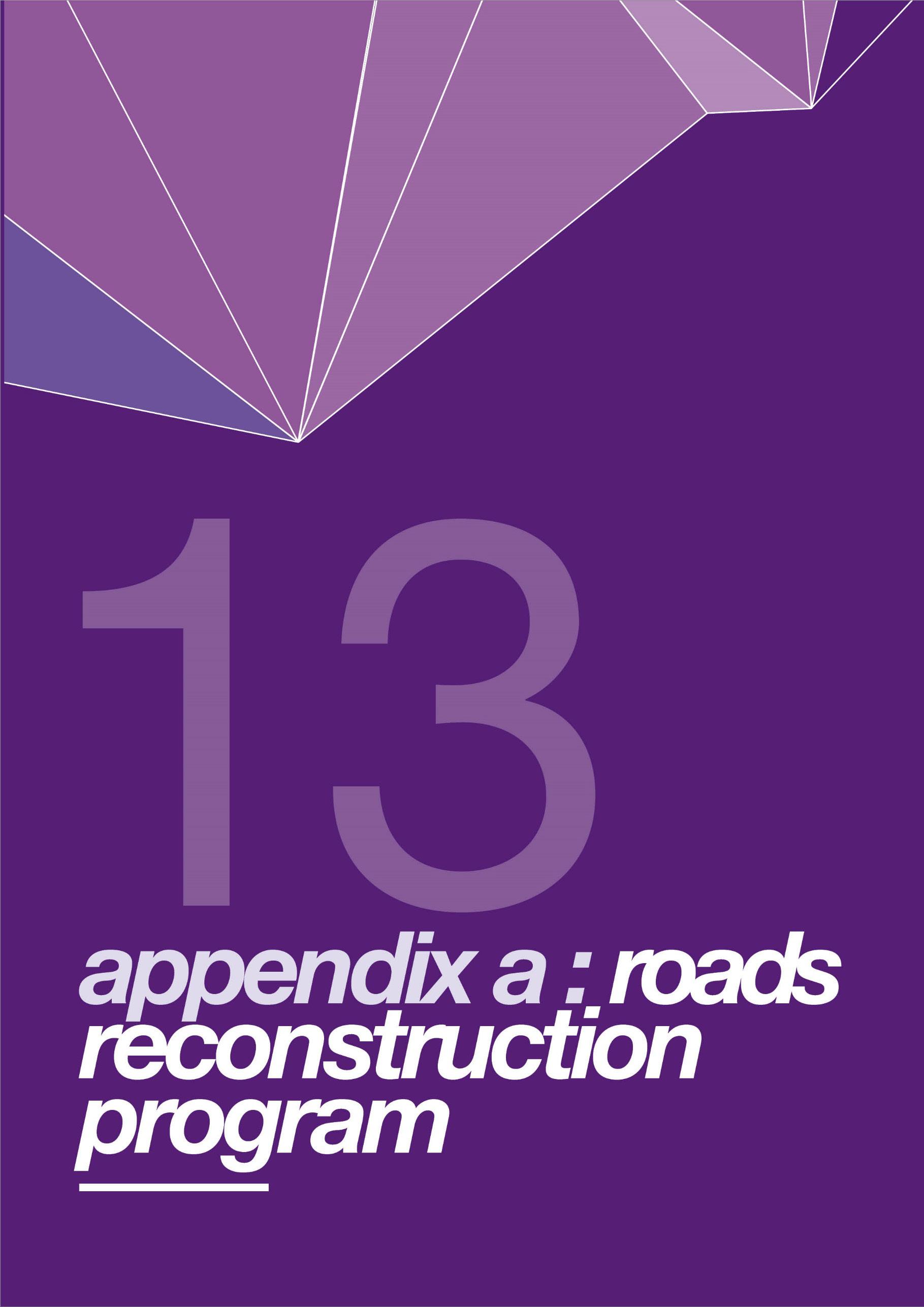

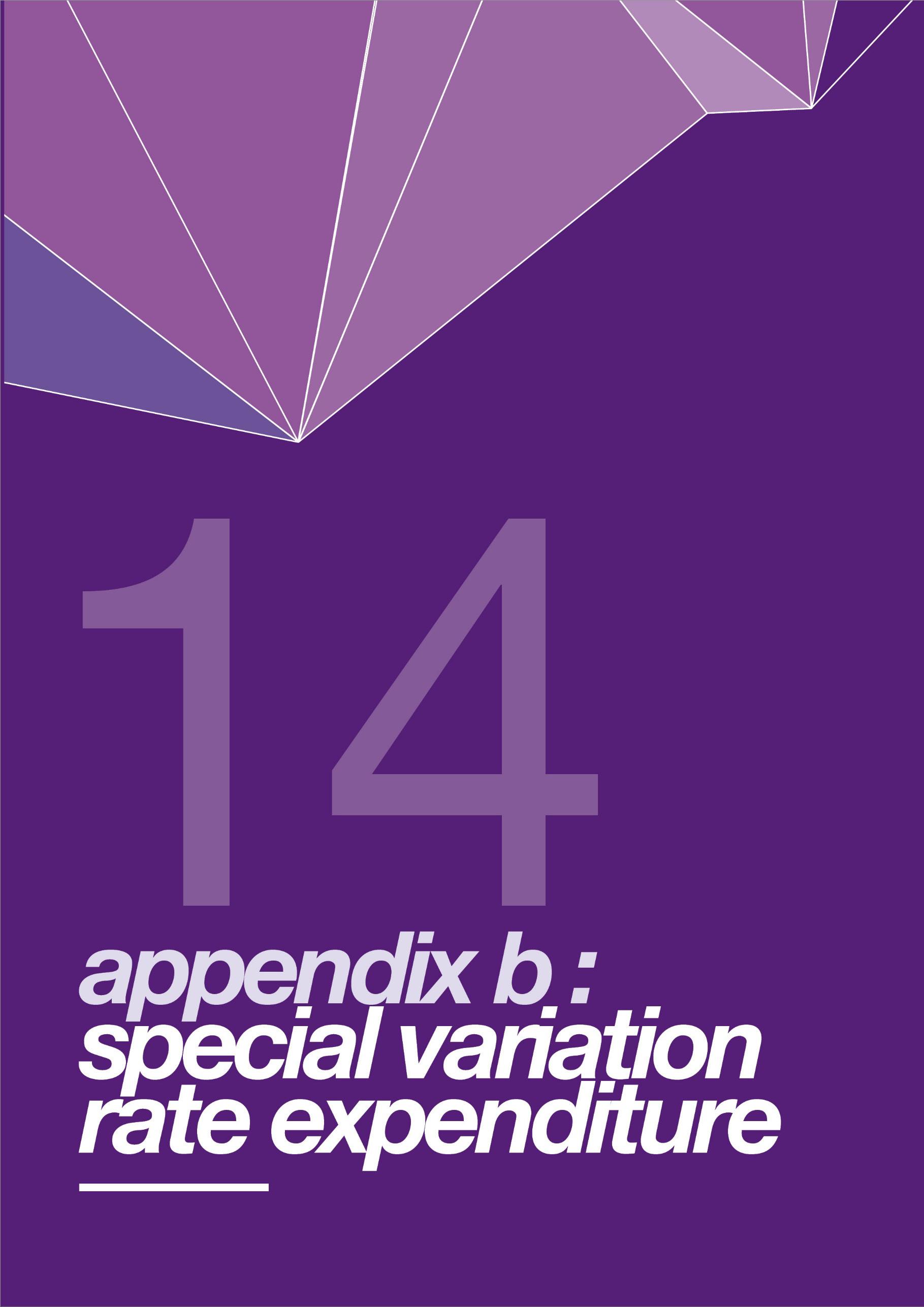
Council’s preferred long term financial plan is based on 2.75% increases in our total rate income above the estimated rate peg limit for the four-year period from 2026/27 to 2029/30, with the extra income raised to be retained as a permanent revenue source. The 2.75% is added to the State Government rate peg limit, which is estimated at 3.25% for 2026/27 onwards., resulting in 6% increases in our total rate income for the four-year period. This is known as a special rate variation, or SRV, and this must be approved by the Independent Pricing and Regulatory Tribunal (IPART).
The extra funds generated from the SRV are to be expended on increased asset renewal (i.e. invested into increased capital expenditure on our core infrastructure assets) and increases in operating expenditure for our Healthy Waterways Program, implementation of our Biodiversity Strategy and implementing Crime Prevention Programs, including the operation of CCTV, as well are additional funding for core infrastructure services. The objectives behind the four-year term of additional rate increases, which provides a permanent increase to our revenue stream, are as follows:
a) Council’s asset management modeling identifies that we are underfunding our investment in asset renewal and maintenance. Over time this will mean the long-term deterioration of the existing asset base. A large part of the extra funds will be allocated to increased operating and capital expenditure on core infrastructure such as roads, footpaths, stormwater, open spaces, sports fields and community buildings.
Undertaking renewal and improvement works in a timelier manner will help to maintain the condition of our assets, save maintenance expenditure and help to retain existing service levels. The current funding shortfall is highlighted by comparing the annual depreciation estimate with the recurrent funding allocated to asset renewal. The following table provides the estimated figures for 2029/30, at the end of the four-year SRV timeframe.
Even with the SRV, there is still a significant shortfall in recurrent funding, although the shortfall reduces from 53% of the depreciation expense funded, to 66%, an improvement of close to $3m. Council should be aiming for 100% as the preferred target, however we want to continue to ensure our rates charged per property remains affordable. Based on this shortfall, the balance of the asset renewal works will to be financed from other sources such as grants, loans, asset sales, reductions in operating expenses, and a combination of all these variables
b) Our long-term financial modelling indicates that without the additional special rate variation revenue our General Fund will continue to operate at a deficit, which means Council is not financially sustainable. This means that Council’s asset base is deteriorating over time in that Council is not fully funding depreciation and adequately investing in the renewal of existing assets. The implementation of the SRV will help to ensure that the General Fund generates an operating surplus in the medium to long term.
c) Council’s Community Importance and Satisfaction Surveys have identified that the health of our waterways, the environment and crime prevention are three of the highest areas of importance to our community. Further details on the survey results are available on our website, with the surveys being undertaken every two years, as per the following link: ballina.nsw.gov.au/engagement
d) The primary focus of the SRV is asset renewal, however the operating expenses for our major infrastructure areas of roads, open spaces and community buildings continue to increase at a rate above CPI. The balance of the SRV funding is allocated to these key areas to ensure that existing service levels can be maintained.
The additional SRV funds are distributed based on key service areas A breakdown of the funding distribution is outlined in the following table, noting that the SRV does not commence until 2026/27.
Expanded Operating
Additional funding allocated to asset renewal allows Council to bring forward capital projects, which results in timelier asset renewal. The following tables highlight the differences in the capital works programs for the infrastructure classes allocated additional funding from the SRV.
The figures are provided for the four-year term of the Delivery Program, with no changes in 2025/26, as the SRV does not commence until 2026/27 and runs for the period from 2026/27 to 2029/30. The works program is indicative and may vary based on final costs for the scheduled works.
Open Spaces and Sports Fields – Without Special Rate Variation ($)
Open Spaces – With Special Rate Variation ($)
Road Reconstruction Program
Urban Roads
Moon Street Segment 20
Head Road Segment 80
Skennars Head Road Segment 70
Cawarra Street Segment 20
Owen Street Segment 20-100
Cherry Street Segment 180
20
10
Crescent Segment 10
Place Segment 10
30
30
Healthy Waterways
Council has been operating a very effective Healthy Waterways Program for several years, with the vision for the program being to “work with the community as a whole to physically change catchment condition across both public and private land tenures for the improvement of flora and fauna habitat, bed and bank stability and water quality".
Details of this program are available as per the following link.
ballina.nsw.gov.au/healthy-waterways
The program currently operates with a recurrent budget of approximately $360,000 and the SRV will see that budget increase to approximately $500,000 by 2029/30.
Many of the actions funded through this program are identified in Council’s Coastal Management Plans, and typically grant funding is needed to allow projects to progress.
The increase in recurrent funding will assist Council in securing additional grants, as well as bring forward projects identified in the four year works program, identified in the overview of this program as per the earlier link to Council’s website.
Biodiversity Strategy
Council adopted the Biodiversity Strategy in 2023 with the vision for the strategy being “to promote understanding of the biodiversity values of Ballina Shire and set out actions that contribute to conserving and enhancing biodiversity in the Shire for future generations”
A copy of the Strategy is available as per the following link.
Biodiversity Strategy 2023 - 2033
When the Strategy was adopted, Council did not have any recurrent funding allocated to the implementation of Action Plan outlined in the Strategy.
Council has commenced incrementally allocating funding to the implementation of the identified actions, with the SRV allocating an extra $100,000, which will see the recurrent budget increase to $300,000 per annum.
This will allow Council to more proactively implement actions in the Strategy, with many of those actions estimated to cost anywhere from $100,000 to $300,000 per project.
Council has resolved to support the installation of CCTV in Ballina and Lennox Head, with the Federal Government committing to funds of $1m for Council to install all the necessary hardware and software.
The recurrent operating costs of maintaining the CCTV network is estimated at up to $50,000 and the SRV will generate the funding for that ongoing maintenance. Any surplus funding will then be allocated to other specific Crime Prevention projects.
The SRV will result in an extra $910,000 allocated per annum, in total, by 2029/30, to these core infrastructure areas.
Council is struggling to maintain existing service levels for this infrastructure, following a period of significantly high increases in costs such as plant and equipment, materials such as asphalt and concrete and the installation of new equipment resulting from successful grant programs and residential development. The total recurrent budget for these areas is approximately $30m and the additional $910,000 will somewhat assist in ensuring service levels are maintained into the future.
Applying for an SRV is always the last option a council should pursue in respect to achieving financial sustainability. Other options that are continually pursued are:
Council has undertaken entrepreneurial activities for decades, with tens of millions of dollars generated from residential and industrial land development. This is a finite resource and does not deliver the recurring income streams required to fund core services.
Council has also created a commercial property portfolio, that is forecast to generate approximately $2.5m per annum from net rental income, with those funds helping to subsidise Council’s comparatively low level of average rate income.
These revenue streams continue to support asset renewal and service delivery, however Council has not been able to identify any significant opportunities to further expand this revenue source, which is why it is essential that the level of rate revenue is at a sustainable level. Our fees and charges have been benchmarked and indexed where possible, with these changes only making a marginal difference to our overall financial performance.
Loan funding does not address the recurrent operating result, and new loans should only be taken up when there is an identified funding source for the associated loan and principal repayments.
Identifying opportunities for efficiency gains and cost savings is core business for Council, as it should be for any organisation.
To enhance operational effectiveness and increase efficiencies, Council established a dedicated Business Process Improvement Taskforce in 2021.
The scope of the Taskforce is to support the Executive Team and Senior Leadership Team in providing process mapping services to assist business owners in identifying and implementing process improvement initiatives.
This allows business owners to ensure that they are delivering services to both internal and external customers efficiently and effectively, while at the same time allowing a contemporary assessment of service levels to form part of the review.
Recent highlights and planned reviews for the Improvement Taskforce include:
• Consolidated and reuse of our construction material - Our road maintenance and construction section, through improved stockpiling and reuse practices, has reduced waste disposal costs by 75%, saving Council $1.7m over the last 20 months, as compared with costs to dispose of the material at the Council operated Waste Management Facility.
• SMS messages on overdue rates and charges – The introduction of SMS reminder messages has reduced the amount (by 10%) of reminder letters sent to ratepayers and improved timeliness of payments. The introduction of SMS commenced in March 2025.
• Commercial Waste Administration – Administration improvements for commercial waste collection were implemented in 2024/25. The process was annual, and now occurs every two years.
• Asset Valuation Software – Improved audit process to identify anomalies in the asset revaluation process for Infrastructure Property, Plant and Equipment (IPPE). This was introduced in 2025.
• Water and Wastewater Assets Insurance – In 2024, Council resolved to transfer the insurance premiums of approximately $200,000/annum to reserve for self-insurance. The insurance premium paid for 2023/24 was in the order of $190,000, with an excess of $100,000. This new model provides Council with an effective cost containment strategy.
• Ballina Wastewater Treatment Plan - Three of five essential components of the treatment plant failed, and money was spent unsuccessfully with contractors. Staff undertook the repairs internally and improved functionality to ensure compliance with environmental standards. Staff sourced parts directly from the German manufacturer, saving Council $54,000.
• Burns Point Ferry Maintenance Improvements – Historically, the ferry is put into slip every year at a cost of more than $200,000. Changes were made in 2024/25 for the annual maintenance to be undertaken internally by Council workshop staff on the water. This saved $75,000 in costs in 2024/25.
• Rural Waste Collection Changes – Reducing the collection of landfill bins from weekly to fortnightly, to align with the urban collection is planned in 2025/26 This service model will improve diversion rates away from landfill and result in significant operational savings, as well as a reduction in annual charges.
• Motor Vehicle Insurance – Increased the excess on motor vehicle insurance for 2025/26 with proposed premium savings of approximately $30,000 per annum.
• Water Leakage – In recent years the unbilled water percentage has decreased from more than 20% to close to 10%, representing additional revenue of more than $1m for Council’s Water Operations.
• Azility Billing Module Implementation - Implementation of this software allows Council to improve utility payment and monitor services and energy usage in a timely manner.
• Contractor Dockets and Invoicing - Streamlining contractor docket processing to increase efficiency in procurement and payment to suppliers. Processing time reduced significantly since implementation.
• Process DPIE Planning Portal Application - Planning Portal process improvement to assist with compliance with new legislation, system integration and time efficiency.
• Infrastructure Contributions - Process review and associated reporting to assist with compliance with new legislation and implementation of Infrastructure Contributions Register.
• Section 138 Applications - Streamlining Section 138 applications process to increase efficiencies and collaboration across multiple sections in Council.
• Onboarding - Onboarding process improvement to increase efficiency, reduce paperwork and increase employee experience satisfaction.
• Customer Service payment process - Improvement to cut inefficiencies and reduce time.
Moving forward, Council has the following scheduled service reviews:
• Road Maintenance Work Requests - Improve processing work requests received by office and depot-based staff of Engineering Works, and the actions that occur to translate these into action.
• Internal Design Services – Small Road Segment Reconstruction Design - Managing risks through appropriate sign off and documentation. Identify any gaps and risks required to be addressed to ensure delivery of safe, compliant and quality internal designs; to identify process improvements for efficient delivery of internal designs and subsequent successful Safer Roads grant funding applications for a proposed "black spot".
• Planning Amendments workflow to final Gazette - Improve all aspects of the process including issues around the planning portal, payment process, and GIS mapping through to gazettal stage.
• Council Easement Management Process – Identification and management of easements in the Developer Application and Subdivision process and reduce public liability risks and improve easement management.
• Procurement - Source to Award Process - To achieve an accountable process map for the full procurement process from identification of business need through to contract award.
• Dual Water Audits - Creation of new records– Improving the process of New Dual Water Audits populating into council systems.
• Works Management Mapping – Treatment Plants – Define all current works management activities for the Treatment plants to fully understand all processes and use this information to relocate the Preventative Maintenance Schedule from Excel into Works Management in Altitude for a complete and refined Treatment Plants works management program.
There are numerous ongoing activities, and one of the difficulties Council faces in further cost savings is that our level of staff per capita, as per the Your Council website, is 137 residents to one employee, as compared to 107 residents, for the Group 4 Council average.
This figure highlights that Council is effectively operating at an efficiency level of 28% greater than comparable councils, which limits our ability to achieve major cost savings.
Council also focuses on core Council services, rather than discretionary programs, which again limits our opportunity to achieve significant savings in our operating budget.
Council will continue to pursue each and every one of these options, however it is essential that our core rate revenue, is at a realistic and sustainable level, which is the key objective of the SRV
Some of the key benchmarks Council has examined in resolving to consult and seek approval for the SRV is our overall level of rate income, our average rate income per assessment compared to similar councils, our total rates and charges, and the ability of the community to pay.
The following table provides the last available comparative information from the Your Council NSW website in respect to average rates per rating category, for the councils in our locality, along with the same category of councils (Group 4).
These are the latest figures published and with Council’s rates income only being subject to the IPART rate peg for 2023/24, 2024/25 and 2025/26, the large differences in dollar values will now be higher due to the financial compounding impact on the average rate income.
The total rates and charges bill is also important when looking at affordability, and the following is the estimated average rates and charges account, for a residential property, for the same councils, based on the information available in the published 202/26 Revenue Policies.
As per these figures, Ballina Shire Council’s average residential rates and charges bill is well under the councils listed, and it is anticipated that this will remain the case even after the implementation of the four-year SRV.
A final indicator is the ability of the community to pay the increases. In looking at this, Council considered the socio- economic index ranking, as provided on the Your Council NSW website, as well as other indicators such as the average taxable income and percentage of pensioners.
Category Ballina Byron Coffs H Lismore Tweed Index (128 highest) (#) 98 100 56 46 78 Income *$)
Rebates (%) 20 14 19 21 23
Based on this information, Council is of the opinion that the community is in a position to afford the proposed increase, with similar councils levying and charging at much higher levels.

Ballina Shire Council 40 Cherry Street Ballina NSW 2478 ph 1300 864 444 I e council@ballina.nsw.gov.au ballina.nsw.gov.au